Introduction
The results reported in the April 2019 bank lending survey (BLS) relate to changes observed during the first quarter of 2019 and expectations for the second quarter of 2019. The survey was conducted between 4 and 19 March 2019. The response rate was 100%. In addition to results for the euro area as a whole, this report also contains results for the five largest euro area countries.[1]
A number of ad hoc questions were included in the April 2019 survey. They address the impact of the situation in financial markets on banks’ access to retail and wholesale funding, the impact of the ECB’s asset purchase programme, the impact of the ECB’s negative deposit facility rate and the level of credit standards compared with a historical range.
1 Overview of results
According to the April 2019 bank lending survey, credit standards remained broadly unchanged for loans to enterprises, which was somewhat more favourable than expected by banks in the previous survey round. By contrast, credit standards tightened for housing loans and consumer credit. Demand for loans to enterprises remained unchanged, while it continued to increase for housing loans.
Credit standards (i.e. banks’ internal guidelines or loan approval criteria) for loans to enterprises remained broadly unchanged in the first quarter of 2019 (net percentage of reporting banks at -1%, unchanged from the previous quarter; see overview table), while banks had expected a slight tightening in the previous survey round. Credit standards on loans to households for house purchase tightened (net percentage of reporting banks at 3%, after -1% in the fourth quarter of 2018), which is broadly in line with expectations. Credit standards on consumer credit and other lending to households continued to tighten slightly (2%, unchanged from the previous quarter), which was broadly as expected by banks. For the second quarter of 2019, banks expect an easing of credit standards for loans to enterprises (-2%) and consumer credit (-9%), and a further tightening of credit standards for housing loans (4%).
Banks’ cost of funds and balance sheet constraints (driven by costs related to banks’ capital position) and risk perceptions (related to a deterioration in the general economic and firm-specific situation) contributed to a tightening of credit standards on loans to enterprises, while competitive pressures (mainly from other banks) continued to contribute to an easing of credit standards. Banks’ risk tolerance had a broadly neutral impact on credit standards for loans to enterprises. For loans to households for house purchase, banks’ cost of funds and balance sheet constraints contributed substantially to a tightening of credit standards, while competition continued to contribute to an easing. Risk perceptions and banks’ risk tolerance had a broadly neutral impact overall. For consumer credit and other lending to households, the impact of these factors was generally smaller than for housing loans, but in the same direction.
Banks’ overall credit terms and conditions (i.e. banks’ actual terms and conditions agreed in the loan contract) on new loans to enterprises and housing loans remained broadly unchanged, following a protracted period of easing. For new loans to enterprises, margins (defined as the spread over relevant market reference rates) continued to narrow for average loans, but tightened for riskier loans. A similar picture applied to housing loans. For consumer credit and other lending to households, banks’ overall terms and conditions have tightened slightly, while margins on average loans have continued to narrow.
The net percentage share of rejected loan applications increased across all loan categories, in particular for housing loans.
Net demand for loans to enterprises remained unchanged in the first quarter of 2019, after having increased since the second quarter of 2015 (net percentage of 0% in the first quarter of 2019, after 9% in the previous quarter; see overview table). This development is broadly in line with banks’ expected moderation of demand in the previous survey round. Banks expect demand to increase somewhat in the second quarter of 2019 (net percentage of 5%). Net demand continued to increase for housing loans (net percentage of 14%, after 12%), while the increase became considerably smaller for consumer credit and other lending to households (net percentage of 2%, after 8%). For the second quarter of 2019, banks expect an increase in net demand for housing loans (10%) and for consumer credit (18%).
According to the banks, demand for loans to enterprises was supported by the low general level of interest rates and fixed investment, as well as, to a smaller extent, by inventories and working capital, merger and acquisition (M&A) activity and debt refinancing/restructuring. Net demand for housing loans continued to be driven mainly by the low general level of interest rates, while favourable housing market prospects and consumer confidence contributed less than in previous quarters. For consumer credit and other lending to households, the low general level of interest rates and spending on durable goods contributed positively to demand, while consumer confidence had a neutral impact, following a positive impact since the second quarter of 2014.
Across the largest euro area countries, credit standards on loans to enterprises eased in France and the Netherlands, remained unchanged in Spain and Italy, and tightened in Germany in the first quarter of 2019 (see overview table). For housing loans, banks eased their credit standards in France and the Netherlands, while they tightened their credit standards in Germany, Spain and Italy. Net demand for loans to enterprises increased in Germany and the Netherlands, while it declined in Spain and Italy and remained unchanged in France. For housing loans, net demand increased in all large euro area countries, except for Italy, where it remained unchanged.
Overview table
Latest developments in BLS results in the largest euro area countries
(net percentages of banks reporting tightening credit standards or an increase in loan demand)
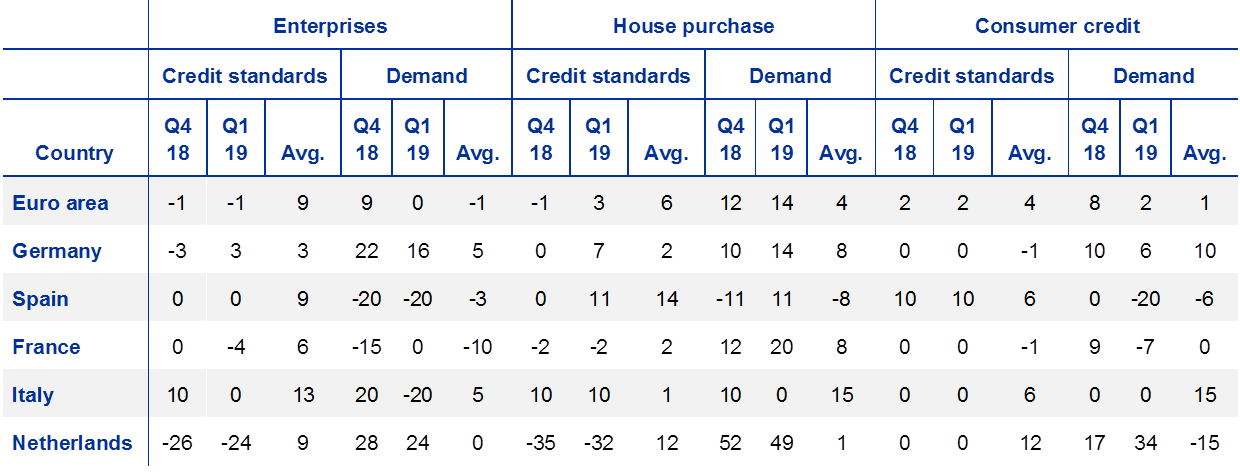
Notes: The “Avg.” columns contain historical averages, which are calculated over the period since the beginning of the survey, excluding the most recent round. For France and the Netherlands, net percentages are weighted on the basis of outstanding loan amounts for individual banks in the respective national samples.
The April 2019 BLS also included a number of ad hoc questions. Regarding euro area banks’ access to wholesale funding, in net terms banks reported that in the first quarter of 2019 access improved for debt securities and, to a small extent, for money markets, while access to securitisation remained broadly unchanged. As regards retail funding, banks indicated an improvement in the first quarter of 2019.
With respect to the impact of the ECB’s asset purchase programme (APP), euro area BLS banks continued to report a positive impact of the APP on their liquidity position and market financing conditions and a negative impact on their profitability over the past six months, which included the Eurosystem’s net asset purchases until December 2018. In addition, the APP had an easing impact on banks’ credit terms and conditions and a positive impact on their lending volumes over the past six months according to reporting banks. Banks expect this favourable impact on bank lending to continue over the coming six months.
Euro area BLS banks reported that the ECB’s negative deposit facility rate (DFR) continued to have a negative impact on their net interest income. At the same time, banks indicated that the negative DFR is continuing to contribute to an increase in lending volumes across all loan categories.
Finally, regarding the current level of credit standards, compared with one year ago a smaller net percentage of the euro area banks assessed their current level of credit standards across all loan categories as tighter than the historical range of credit standards since 2003. This reflects the net easing of credit standards over the last year. When comparing the current level of credit standards with a shorter historical range of credit standards since 2010, in net terms banks assessed their current level of credit standards as broadly similar for loans to enterprises, as somewhat tighter for housing loans and somewhat looser for consumer credit.
Box 1
General notes
The bank lending survey (BLS) is addressed to senior loan officers at a representative sample of euro area banks. In the current survey round, 144 banks participated in the survey, representing all euro area countries and reflecting the characteristics of their respective national banking structures. The main purpose of the BLS is to enhance the Eurosystem’s knowledge of bank lending conditions in the euro area.[2]
BLS questionnaire
The BLS questionnaire contains 22 standard questions on past and expected future developments: 18 backward-looking questions and four forward-looking questions. In addition, it contains one open-ended question. Those questions focus on developments in loans to euro area residents (i.e. domestic and euro area cross-border loans) and distinguish between three loan categories: loans or credit lines to enterprises; loans to households for house purchase; and consumer credit and other lending to households. For all three categories, questions are asked about the credit standards applied to the approval of loans, the terms and conditions of new loans, loan demand, the factors affecting loan supply and demand conditions, and the percentage of loan applications that are rejected. Survey questions are generally phrased in terms of changes over the past three months or expected changes over the next three months. Survey participants are asked to indicate in a qualitative way the strength of any tightening or easing or the strength of any decrease or increase, reporting changes using the following five-point scale: (1) tightened/decreased considerably, (2) tightened/decreased somewhat, (3) basically no change, (4) eased/increased somewhat or (5) eased/increased considerably.
In addition to the standard questions, the BLS questionnaire may contain ad hoc questions on specific topics of interest. Whereas the standard questions cover a three-month time period, the ad hoc questions tend to refer to changes over a longer time period (e.g. over the past and next six months).
Aggregation of banks’ replies to national and euro area BLS results
The responses of the individual banks participating in the BLS are aggregated in two steps. In the first step, the responses of individual banks are aggregated to form national results for euro area countries. And in the second step, those national BLS results are aggregated to form euro area BLS results.
In the first step, banks’ replies can be aggregated to form national BLS results by applying equal weights to all banks in the sample[3] or, alternatively, by applying a weighting scheme based on outstanding loans to non-financial corporations and households for the individual banks in the respective national samples. Specifically, for France, Malta, the Netherlands and Slovakia, an explicit weighting scheme is applied.
In the second step, since the numbers of banks in the national samples differ considerably and do not always reflect those countries’ respective shares of lending to euro area non-financial corporations and households, the national survey results are aggregated to form euro area BLS results by applying a weighting scheme based on national shares of outstanding loans to euro area non-financial corporations and households.
BLS indicators
Responses to questions related to credit standards are analysed in this report by looking at the difference (the “net percentage”) between the percentage of banks reporting that credit standards applied in the approval of loans have been tightened and the percentage of banks reporting that they have been eased. For all questions, the net percentage is determined on the basis of all participating banks that have business in or exposure to the respective loan categories (i.e. they are all included in the denominator when calculating the net percentage). This means that banks that specialise in certain loan categories (e.g. banks that only grant loans to enterprises) are only included in the aggregation for those categories. All other participating banks are included in the aggregation of all questions, even if a bank replies that a question is “not applicable” (“NA”). This harmonised aggregation method was introduced by the Eurosystem in the April 2018 BLS. It has been applied to all euro area and national BLS results in the current BLS questionnaire, including backdata.[4] The resulting revisions for the standard BLS questions have generally been small, but revisions for some ad hoc questions have been larger owing to a higher number of “not applicable” replies by banks.
A positive net percentage indicates that a larger proportion of banks have tightened credit standards (“net tightening”), whereas a negative net percentage indicates that a larger proportion of banks have eased credit standards (“net easing”).
Likewise, the term “net demand” refers to the difference between the percentage of banks reporting an increase in loan demand (i.e. an increase in bank loan financing needs) and the percentage of banks reporting a decline. Net demand will therefore be positive if a larger proportion of banks have reported an increase in loan demand, whereas negative net demand indicates that a larger proportion of banks have reported a decline in loan demand.
In the assessment of survey balances for the euro area, net percentages between -1 and +1 are generally referred to as “broadly unchanged”. For the country results, net percentage changes are reported in a factual manner, as differing sample sizes across countries mean that the answers of individual banks have differing impacts on the magnitude of net percentage changes.
In addition to the “net percentage” indicator, the ECB also publishes an alternative measure of banks’ responses to questions related to changes in credit standards and net demand. This measure is the weighted difference (“diffusion index”) between the percentage of banks reporting that credit standards have been tightened and the percentage of banks reporting that they have been eased. Likewise, as regards demand for loans, the diffusion index refers to the weighted difference between the percentage of banks reporting an increase in loan demand and the percentage of banks reporting a decline. The diffusion index is constructed in the following way: lenders who have answered “considerably” are given a weight (score of 1) twice as high as lenders having answered “somewhat” (score of 0.5). The interpretation of the diffusion indices follows the same logic as the interpretation of net percentages.
Detailed tables and charts based on the responses provided can be found in Annex 1 for the standard questions and Annex 2 for the ad hoc questions. In addition, BLS time series data are available on the ECB’s website via the Statistical Data Warehouse.
A copy of the questionnaire, a glossary of BLS terms and a BLS user guide with information on the BLS series keys can all be found at: https://www.ecb.europa.eu/stats/ecb_surveys/bank_lending_survey/html/index.en.html
2 Developments in credit standards, terms and conditions, and net demand for loans in the euro area
2.1 Loans to enterprises
2.1.1 Credit standards for loans to enterprises remained broadly unchanged
Credit standards (i.e. banks’ internal guidelines or loan approval criteria) for loans to enterprises remained broadly unchanged in the first quarter of 2019 (with the net percentage of banks standing at -1%, unchanged from the previous quarter; see Chart 1 and overview table). By contrast, banks had expected a slight net tightening in the previous round. The net percentage remained below the historical average since 2003. Across firm size, credit standards remained broadly unchanged for loans to small and medium-sized enterprises (SMEs) (1%) and continued to ease for loans to large firms (-5%).
Chart 1
Changes in credit standards applied to the approval of loans or credit lines to enterprises, and contributing factors
(net percentages of banks reporting tightening credit standards and contributing factors)
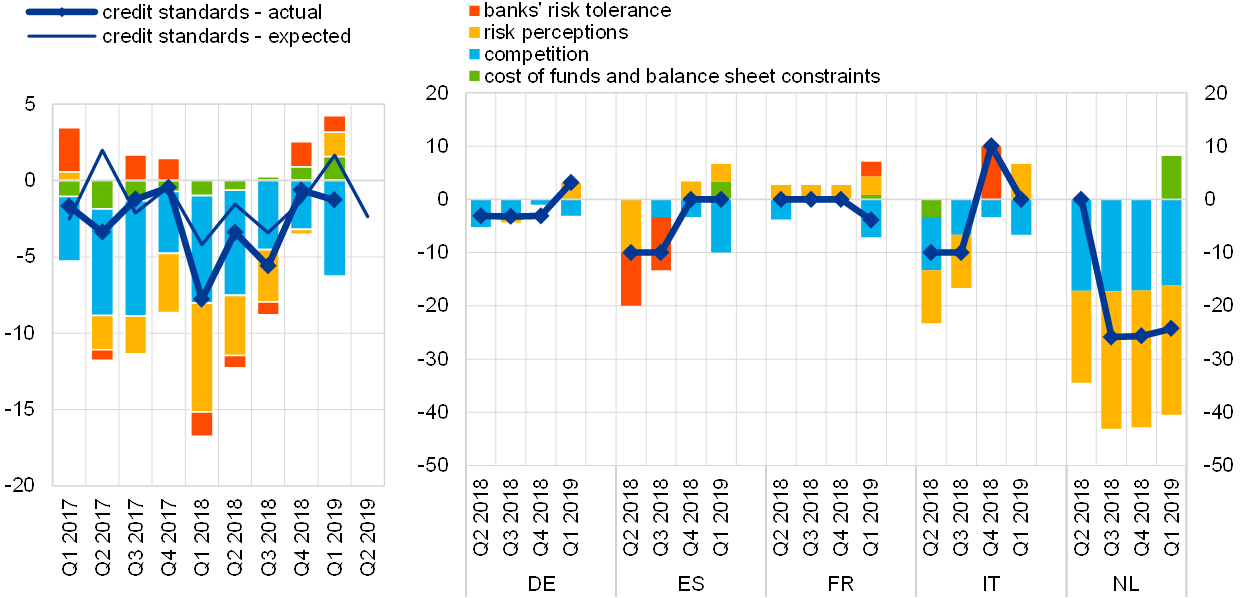
Notes: “Actual” values are changes that have occurred, while “expected” values are changes anticipated by banks. Net percentages are defined as the difference between the sum of the percentages of banks responding “tightened considerably” and “tightened somewhat” and the sum of the percentages of banks responding “eased somewhat” and “eased considerably”. The net percentages for responses to questions related to contributing factors are defined as the difference between the percentage of banks reporting that the given factor contributed to a tightening and the percentage reporting that it contributed to an easing. “Cost of funds and balance sheet constraints” is the unweighted average of “costs related to capital position”, “access to market financing” and “liquidity position”; “risk perceptions” is the unweighted average of “general economic situation and outlook”, “industry or firm-specific situation and outlook/borrower’s creditworthiness” and “risk related to the collateral demanded”; “competition” is the unweighted average of “competition from other banks”, “competition from non-banks” and “competition from market financing”.
Banks’ cost of funds and balance sheet constraints (driven by costs related to banks’ capital position) and risk perceptions (related to a deterioration in the general economic and firm-specific situation) contributed to a tightening of credit standards on loans to enterprises, while competitive pressures (mainly from other banks) continued to contribute to an easing of credit standards. Banks’ risk tolerance had a broadly neutral impact on credit standards for loans to enterprises in the first quarter of 2019 (see Chart 1 and Table 1).[5]
Across the large euro area countries, credit standards on loans to enterprises eased in France and the Netherlands, remained unchanged in Spain and Italy, and tightened in Germany in the first quarter of 2019. Competitive pressures had an easing impact on credit standards in all large euro area countries. By contrast, risk perceptions related to the general economic and firm-specific situation contributed to a tightening in most large euro area countries, except for the Netherlands. Banks in Spain, France and the Netherlands referred to a tightening impact of costs related to banks’ capital position (included in “cost of funds and balance sheet constraints”). With regard to banks’ risk tolerance, most countries reported a neutral impact.
Looking ahead to the second quarter of 2019, euro area banks expect an easing of credit standards for loans to enterprises (-2%).
Table 1
Factors contributing to the net tightening of credit standards for loans or credit lines to enterprises
(net percentages of banks)
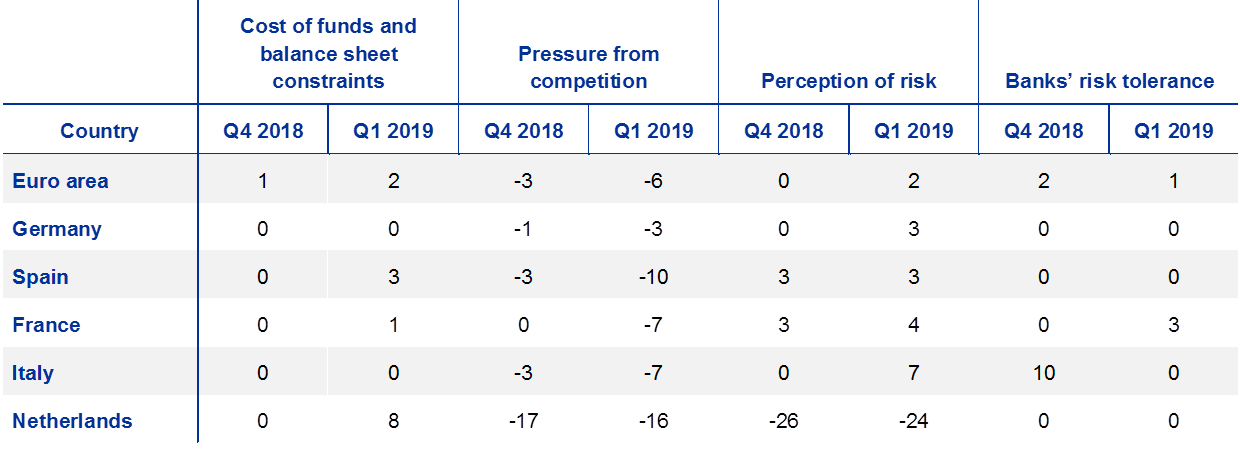
Note: See the notes to Chart 1.
2.1.2 Terms and conditions for loans to enterprises remained broadly unchanged
In the first quarter of 2019, overall terms and conditions that banks apply when granting new loans or credit lines to enterprises (i.e. the actual terms and conditions agreed in the loan contract) remained broadly unchanged (see Chart 2 and Table 2) following a protracted period of easing. While margins on average loans (defined as the spread over relevant market reference rates) continued to narrow, margins on riskier loans widened for the second quarter in a row according to reporting banks. Regarding other credit terms and conditions, loan size and loan covenants contributed to an easing, while non-interest rate charges had some tightening impact.
Chart 2
Changes in terms and conditions for loans or credit lines to enterprises
(net percentages of banks reporting tightening terms and conditions)
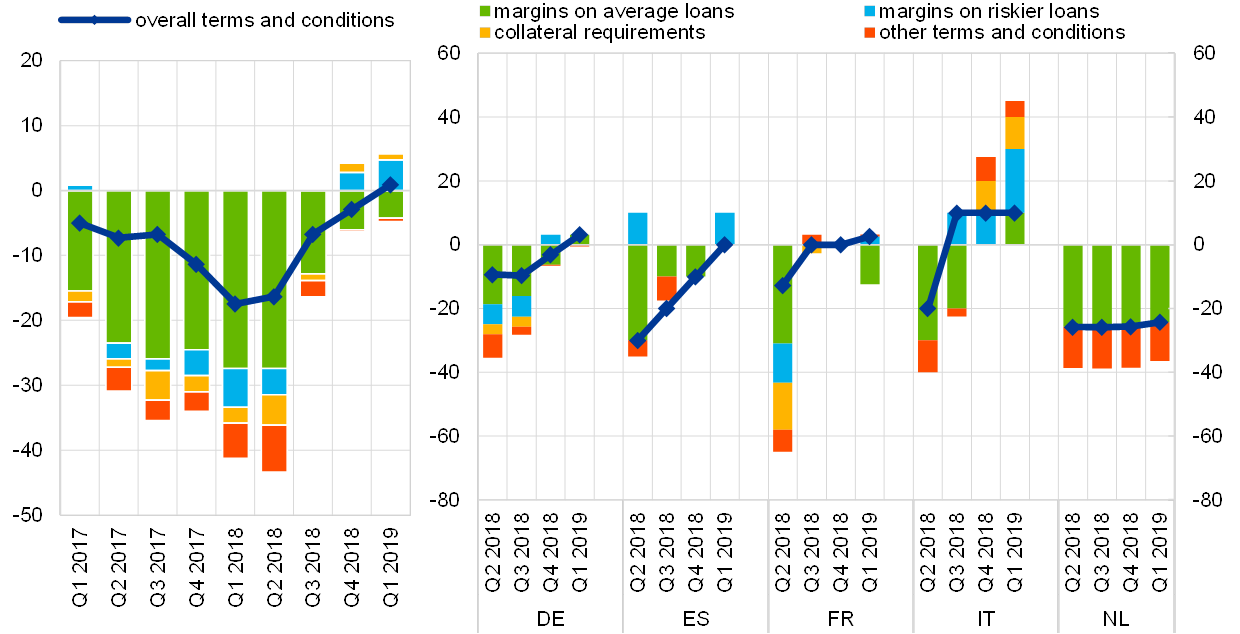
Notes: “Margins” are defined as the spread over a relevant market reference rate. “Other terms and conditions” is the unweighted average of “non-interest rate charges”, “size of the loan or credit line”, “loan covenants” and “maturity”.
Across the largest euro area countries, overall terms and conditions for new loans or credit lines to enterprises tightened in Germany, France and Italy, while they eased in the Netherlands. The tightening was mostly related to a widening of margins on average and/or riskier loans. In Italy, it was somewhat broader based and also affected, for instance, non-interest rate charges. In the Netherlands, the easing of terms and conditions was related to a narrowing of margins on average loans and an easing impact of loan size and loan covenants.
Table 2
Changes in terms and conditions for loans or credit lines to enterprises
(net percentages of banks)
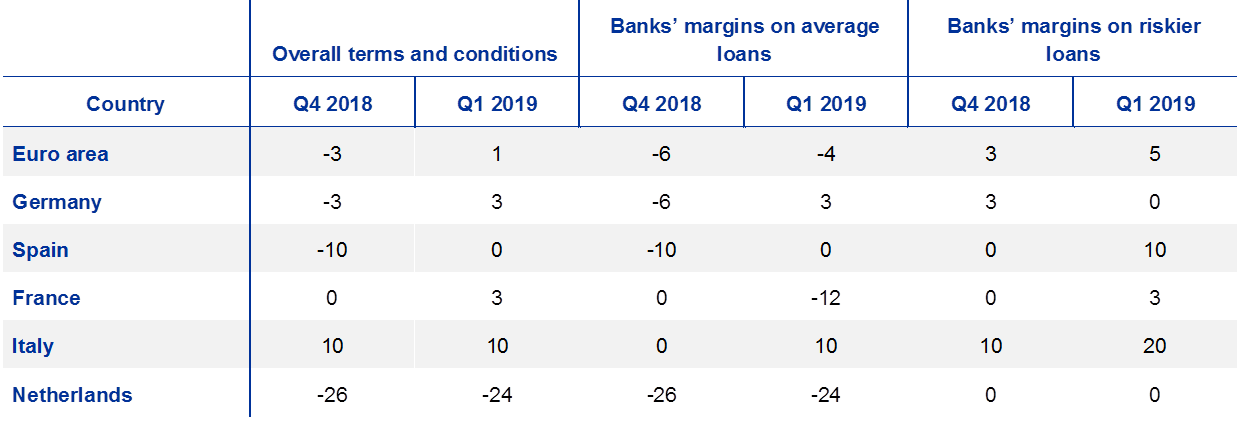
Note: See the notes to Chart 2.
Regarding the factors contributing to changes in overall credit terms and conditions, competition continued to contribute to an easing, while banks’ cost of funds and balance sheet constraints and risk perceptions had a tightening impact. Changes in terms and conditions were mostly not related to changes in banks’ risk tolerance (see Table 3).
Across the largest euro area countries, competitive pressures had an easing impact on credit terms and conditions in most countries. In addition, banks in Germany, France and Italy reported a tightening impact of banks’ cost of funds and balance sheet constraints, while the tightening impact of risk perceptions was concentrated in Italy.
Table 3
Factors contributing to the net tightening of overall terms and conditions for loans or credit lines to enterprises
(net percentages of banks)
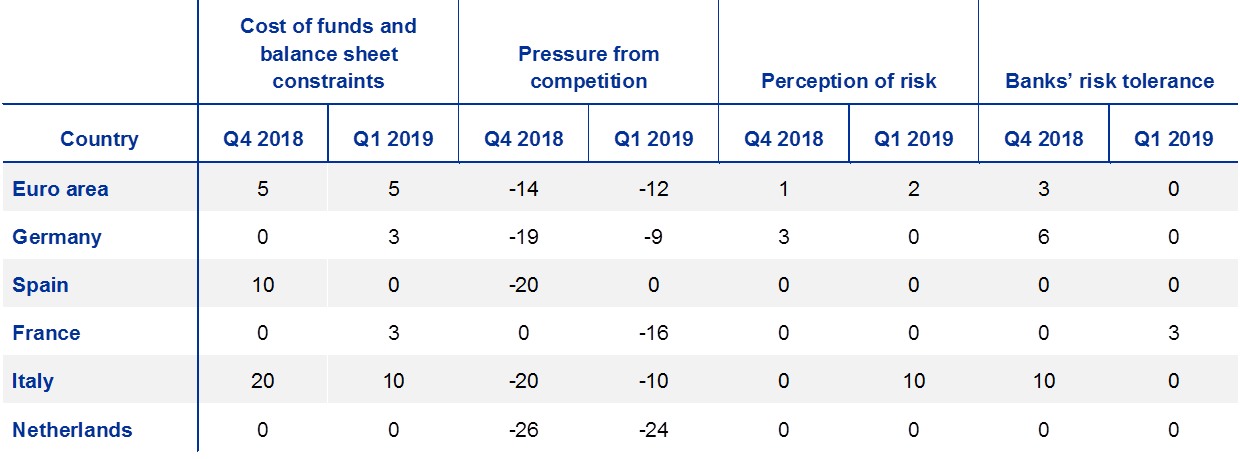
Note: The net percentages for these questions relating to contributing factors are defined as the difference between the percentage of banks reporting that the given factor contributed to a tightening and the percentage reporting that it contributed to an easing.
2.1.3 Rejection rate for loans to enterprises continued to increase
The net percentage share of rejected loan applications (i.e. the difference between the percentage of banks reporting an increase and the percentage reporting a decline in the share of loan rejections) continued to increase for loans to euro area enterprises in the first quarter of 2019 (2%, after 5% in the previous quarter; see Chart 3).
Chart 3
Change in the share of rejected applications for loans to enterprises
(net percentages of banks reporting an increase in the share of rejections)
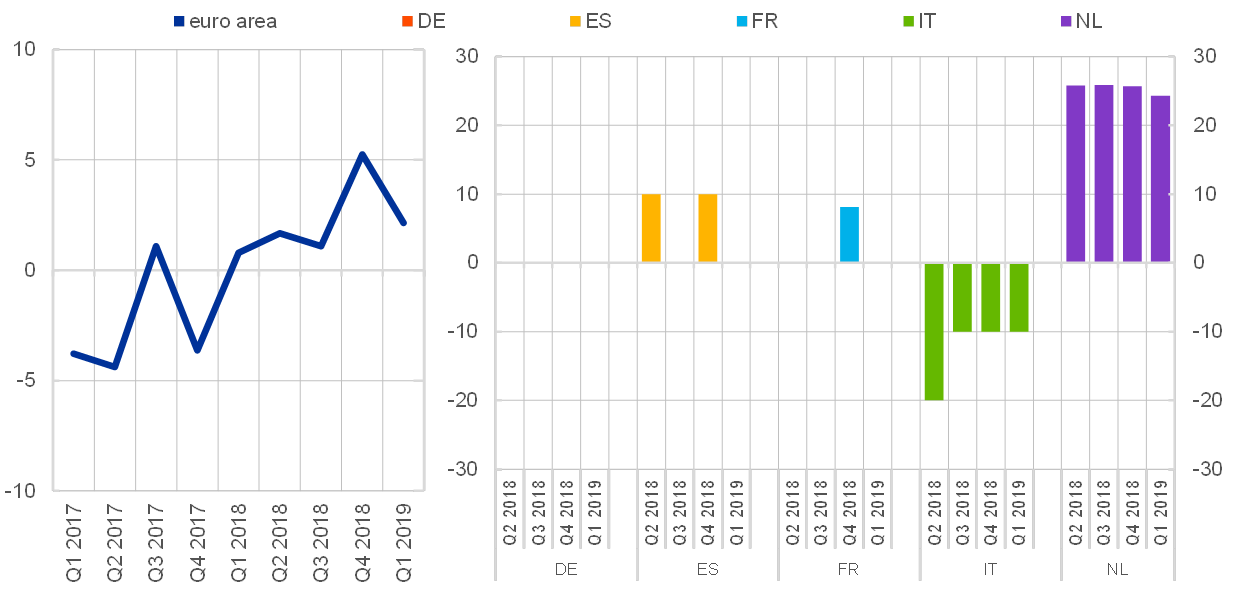
Note: Share of loan rejections relative to the volume of all loan applications in that loan category.
Across the largest euro area countries, the net rejection rate increased in the Netherlands, while it remained unchanged in Germany, Spain and France and declined in Italy.
2.1.4 Net demand for loans to enterprises remained stable
Net demand for loans to enterprises remained stable in the first quarter of 2019 (the net percentage of banks reporting an increase was 0%, after 9% in the previous quarter; see Chart 4 and overview table), after having increased since the second quarter of 2015. This development was roughly in line with banks’ expected moderation in the previous survey round and slightly above the historical average. Demand increased for loans to SMEs, but less than in previous quarters, and remained unchanged for loans to large firms.
Across the large euro area countries, net demand for loans to enterprises increased in Germany and the Netherlands, while it declined in Spain and Italy and remained unchanged in France.
Chart 4
Changes in demand for loans or credit lines to enterprises, and contributing factors
(net percentages of banks reporting an increase in demand and contributing factors)
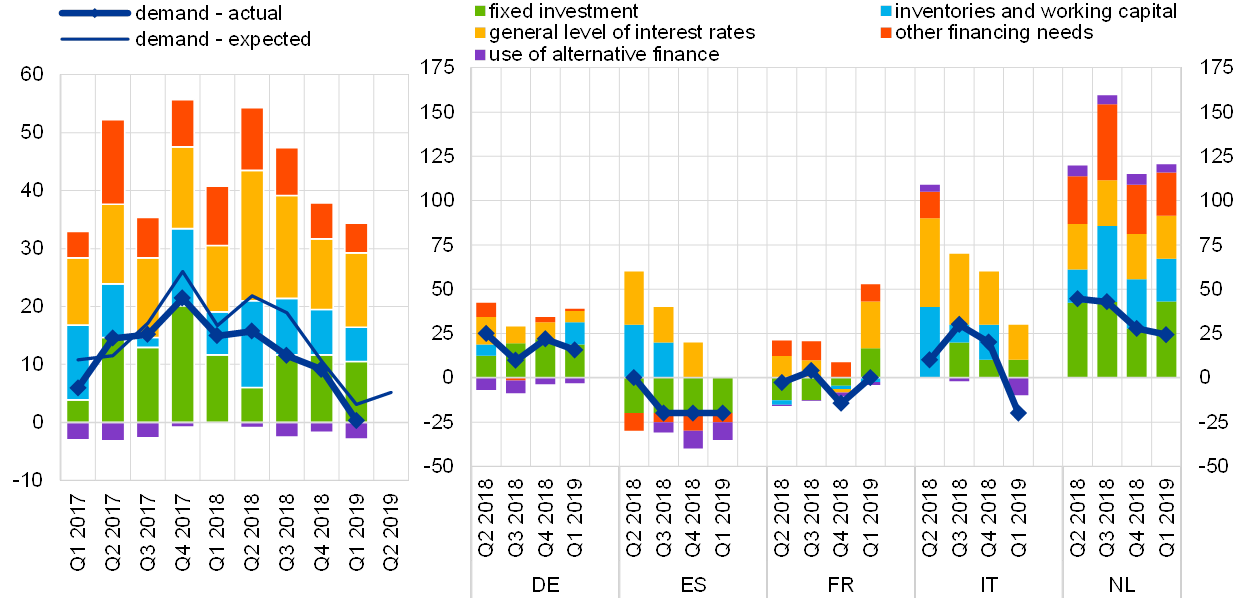
Notes: “Actual” values are changes that have occurred, while “expected” values are changes anticipated by banks. Net percentages for the questions on demand for loans are defined as the difference between the sum of the percentages of banks responding “increased considerably” and “increased somewhat” and the sum of the percentages of banks responding “decreased somewhat” and “decreased considerably”. The net percentages for responses to questions related to contributing factors are defined as the difference between the percentage of banks reporting that the given factor contributed to increasing demand and the percentage reporting that it contributed to decreasing demand. “Other financing needs” is the unweighted average of “mergers/acquisitions and corporate restructuring” and “debt refinancing/restructuring and renegotiation”; “use of alternative finance” is the unweighted average of “internal financing”, “loans from other banks”, “loans from non-banks”, “issuance/redemption of debt securities” and “issuance/redemption of equity”.
According to the reporting banks, demand for loans to enterprises was supported by the low general level of interest rates and fixed investment, as well as, to a smaller extent, by inventories and working capital, M&A activity and debt refinancing/ restructuring leading to an increase or prolongation of the amount borrowed (the last two items are included in “other financing needs”; see Chart 4 and Table 4). Firms’ internal financing, loans from other banks and the use of non-bank and market-based financing (all included in “use of alternative finance”) had a negative impact on firms’ loan demand.[6]
Table 4
Factors contributing to net demand for loans or credit lines to enterprises
(net percentages of banks)
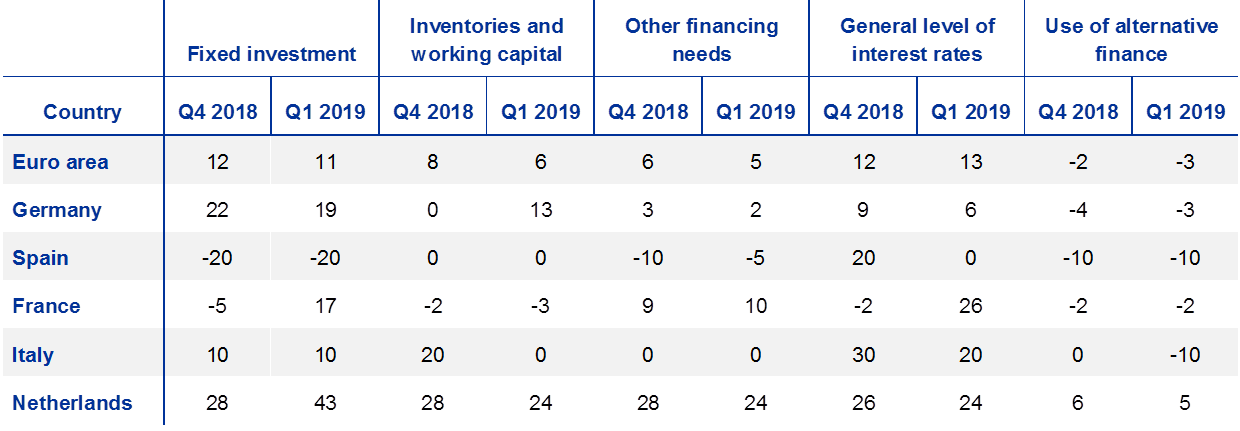
Note: See the notes to Chart 4.
Across the largest euro area countries, the low general level of interest rates and fixed investment supported loan demand in most major euro area countries, except for Spain. In addition, inventories and working capital had a positive impact on demand in Germany and the Netherlands. A positive impact from M&A activity was reported, mainly by banks in France. Concerning the reported net decrease in loan demand in Spain and Italy, banks referred mainly to alternative financing sources and, in Spain, to fixed investment.
For the second quarter of 2019, banks expect a net increase in loan demand from enterprises (net percentage of 5%).
2.2 Loans to households for house purchase
2.2.1 Credit standards for loans to households for house purchase tightened
Credit standards on loans to households for house purchase tightened in the first quarter of 2019, following broadly stable credit standards in the previous quarter (3%, after -1% in the previous quarter; see Chart 5 and overview table). This was broadly in line with banks’ expectations in the previous quarter. The net percentage remains below the historical average since 2003.
Across the largest euro area countries, banks eased credit standards in France and the Netherlands, while they tightened credit standards in Germany, Spain and Italy.
Chart 5
Changes in credit standards applied to the approval of loans to households for house purchase, and contributing factors
(net percentages of banks reporting tightening credit standards and contributing factors)
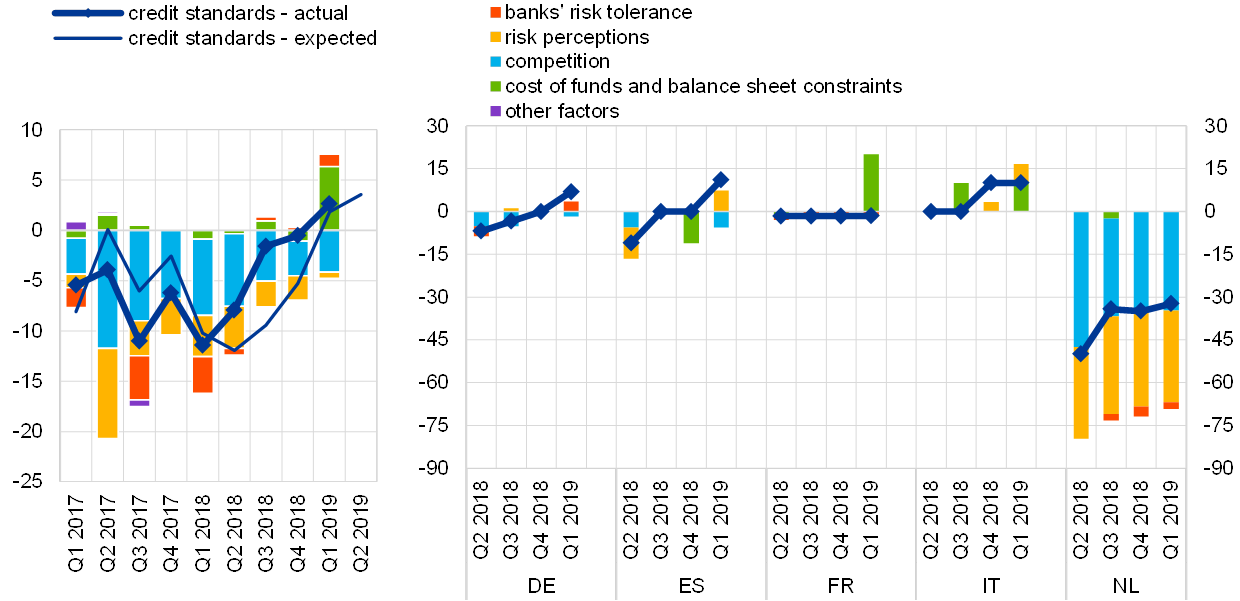
Notes: See the notes to Chart 1. “Risk perceptions” is the unweighted average of “general economic situation and outlook”, “housing market prospects, including expected house price developments” and “borrower’s creditworthiness”; “competition” is the unweighted average of “competition from other banks” and “competition from non-banks”. “Other factors” are provided by banks when none of the above factors are applicable. They are shown as memo items and refer here, in particular, to changes in the regulations and legislation governing housing markets.
Banks’ cost of funds and balance sheet constraints contributed substantially to a tightening of credit standards, while competition continued to contribute to an easing. Risk perceptions and banks’ risk tolerance had a broadly neutral impact overall at the euro area level (see Chart 5 and Table 5).
Across the largest euro area countries, the reported tightening in Italy was mainly related to banks’ cost of funds and balance sheet constraints and to the general economic situation. Banks in France also referred to a tightening impact of their cost of funds and balance sheet constraints, related to supervisory capital ratios, while banks’ risk tolerance contributed to an easing. In Spain, the reported tightening of credit standards on housing loans was related to the general economic situation and housing market prospects. Finally, in Germany the tightening was partly related to banks’ risk tolerance.
Looking ahead, euro area banks expect that credit standards for housing loans will tighten further (4%) in the second quarter of 2019.
Table 5
Factors contributing to the net tightening of credit standards for loans to households for house purchase
(net percentages of banks)
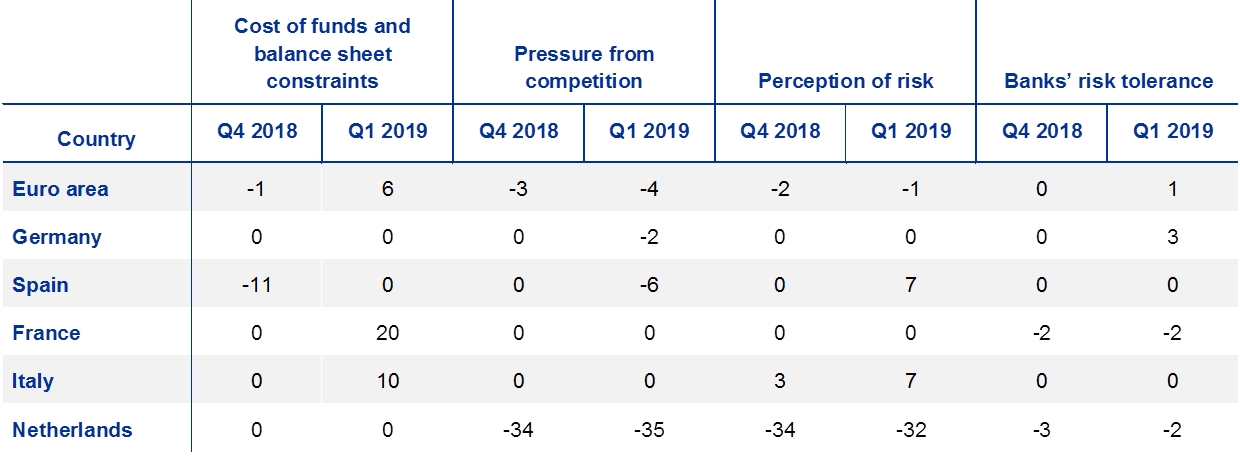
Note: See the notes to Chart 5.
2.2.2 Terms and conditions for loans to households for house purchase remained broadly unchanged
Banks’ overall terms and conditions for new loans to households for house purchase remained broadly unchanged in the first quarter of 2019 (see Chart 6 and Table 6), following an extended easing period. According to reporting banks, this development was due to broadly unchanged margins on average housing loans, following a substantial narrowing of these margins since mid-2013. In addition, margins on riskier loans widened slightly in the first quarter of 2019. Most other terms and conditions remained broadly unchanged.
Chart 6
Changes in terms and conditions for loans to households for house purchase
(net percentages of banks reporting tightening terms and conditions)
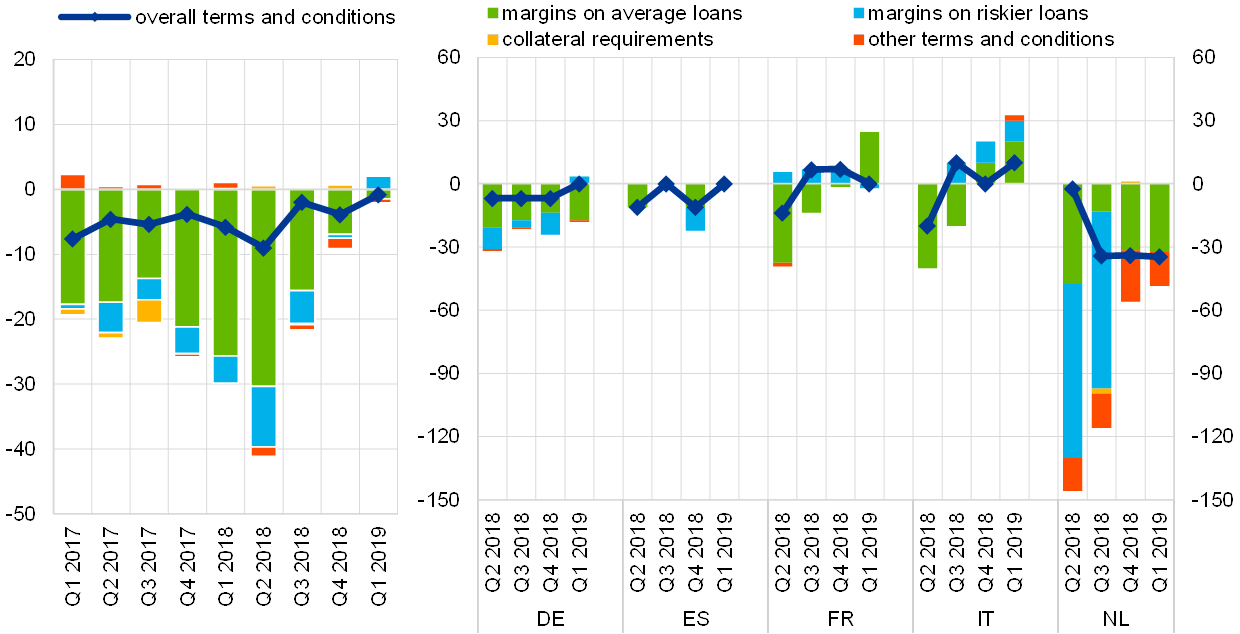
Notes: “Margins” are defined as the spread over a relevant market reference rate. “Other terms and conditions” is the unweighted average of “loan-to-value ratio”, “other loan size limits”, “non-interest rate charges” and “maturity”.
Of the largest euro area countries, banks in Germany, Spain and France reported unchanged overall terms and conditions on housing loans, while banks in Italy reported a net tightening and banks in the Netherlands a net easing. The net tightening in Italy was related to a widening of margins on both average and riskier loans. There was also a net widening of margins on average housing loans in France, while banks in Germany indicated a widening of margins on riskier loans. The net easing in the Netherlands was due to a further narrowing of margins on average loans. Other terms and conditions remained broadly unchanged in most major euro area countries. At the same time, the lengthening of loan maturities and loan size limits contributed to an easing of terms and conditions in the Netherlands, while non-interest rate charges contributed to a tightening of terms and conditions for housing loans in Italy.
Table 6
Changes in terms and conditions for loans to households for house purchase
(net percentages of banks)
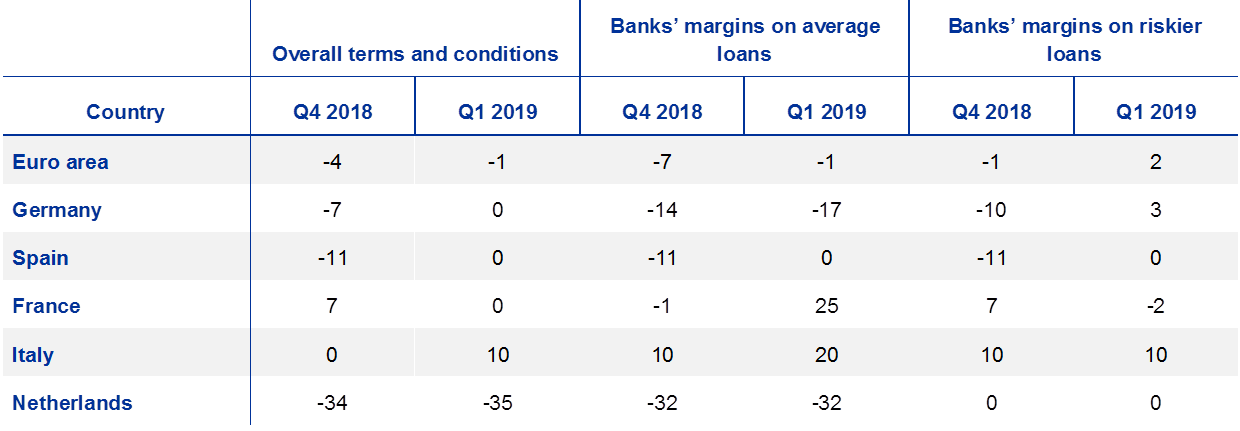
Note: See the notes to Chart 6.
While competitive pressure remained the main contributor to an easing of overall terms and conditions for housing loans at the euro area level, banks’ cost of funds and balance sheet constraints contributed to a tightening (see Table 7). Risk perceptions also had some easing impact, while banks’ risk tolerance had a neutral impact on terms and conditions for housing loans at the euro area level.
Both the easing impact of competitive pressures and the tightening impact of banks’ cost of funds and balance sheet situation applied across most large euro area countries.
Table 7
Factors contributing to the net tightening of overall terms and conditions for loans to households for house purchase
(net percentages of banks)
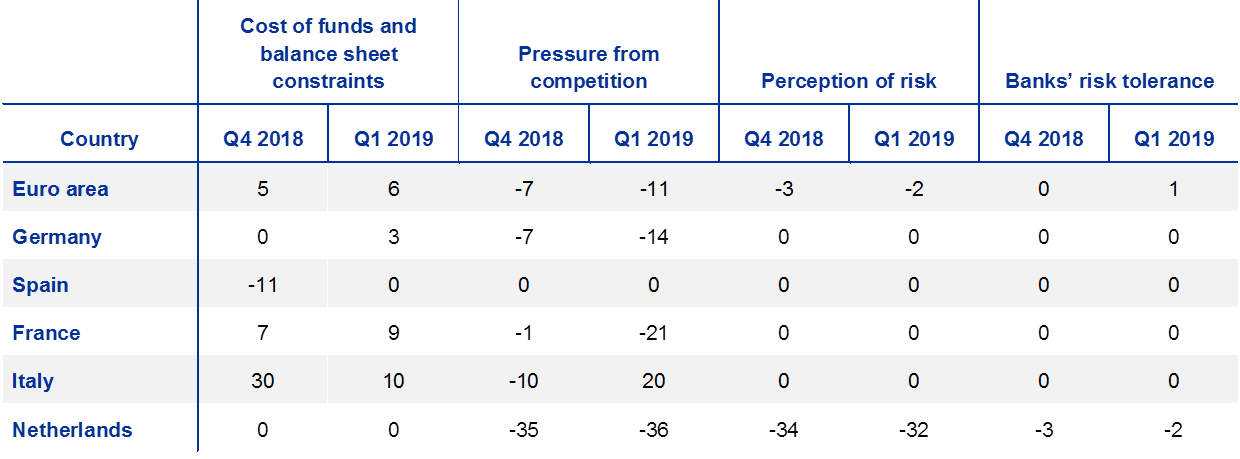
Note: The net percentages for these questions relating to contributing factors are defined as the difference between the percentage of banks reporting that the given factor contributed to a tightening and the percentage reporting that it contributed to an easing.
2.2.3 Rejection rate for housing loans increased
According to euro area banks, the net share of rejected applications for loans to households for house purchase increased again in the first quarter of 2019 (9%, after 7% in the previous survey round; see Chart 7).
Chart 7
Change in the share of rejected applications for loans to households for house purchase
(net percentages of banks reporting an increase in the share of rejections)
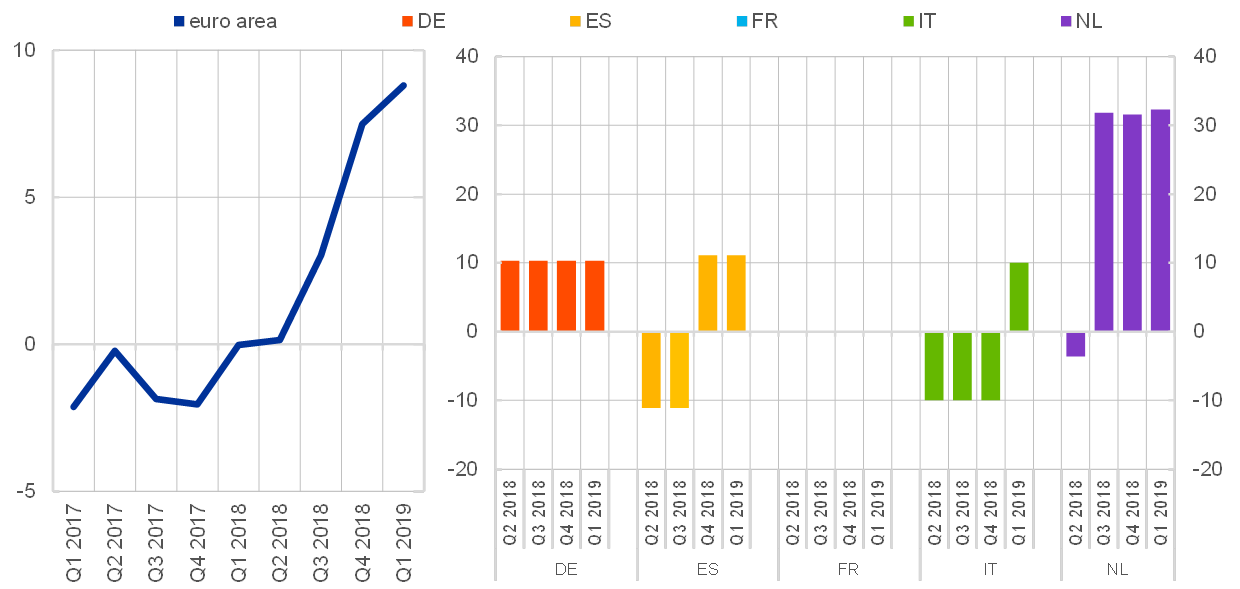
Note: Share of loan rejections relative to the volume of all loan applications in that loan category.
Across the largest euro area countries, the rejection rate for housing loans increased in Germany, Spain, Italy and the Netherlands, and remained unchanged in France.
2.2.4 Net demand for housing loans continued to increase
In the first quarter of 2019, banks reported a continued net increase in demand for housing loans (14%, after 12% in the previous quarter; see Chart 8 and overview table), which was above the historical average for housing loan demand and higher than expected by banks in the previous survey round.
Net demand increased in all large euro area countries, except for Italy, where it remained unchanged.
Net demand for housing loans continued to be driven mainly by the low general level of interest rates, while favourable housing market prospects and consumer confidence contributed less than in previous quarters. Other financing needs, such as the regulatory and fiscal regime of housing markets, led to some increase in housing loan demand according to reporting banks, while the use of alternative sources of finance had a slight dampening effect on demand, mainly owing to households’ internal financing capacity (see Chart 8 and Table 8).
The low general level of interest rates had a positive impact on housing loan demand in most large euro area countries, except for Italy. In addition, favourable housing market prospects supported housing loan demand in Germany, France and the Netherlands, while housing market prospects dampened demand in Spain and Italy. Banks in Germany and the Netherlands also referred to a positive impact of consumer confidence, while the impact was neutral in the other major euro area countries. A supportive impact from the regulatory and fiscal regime of housing markets was mentioned by banks in Spain and the Netherlands. Finally, the use of alternative finance dampened demand in Germany and Spain, mainly owing to households’ internal financing capacity and loans from other banks.
Chart 8
Changes in demand for loans to households for house purchase, and contributing factors
(net percentages of banks reporting an increase in demand and contributing factors)
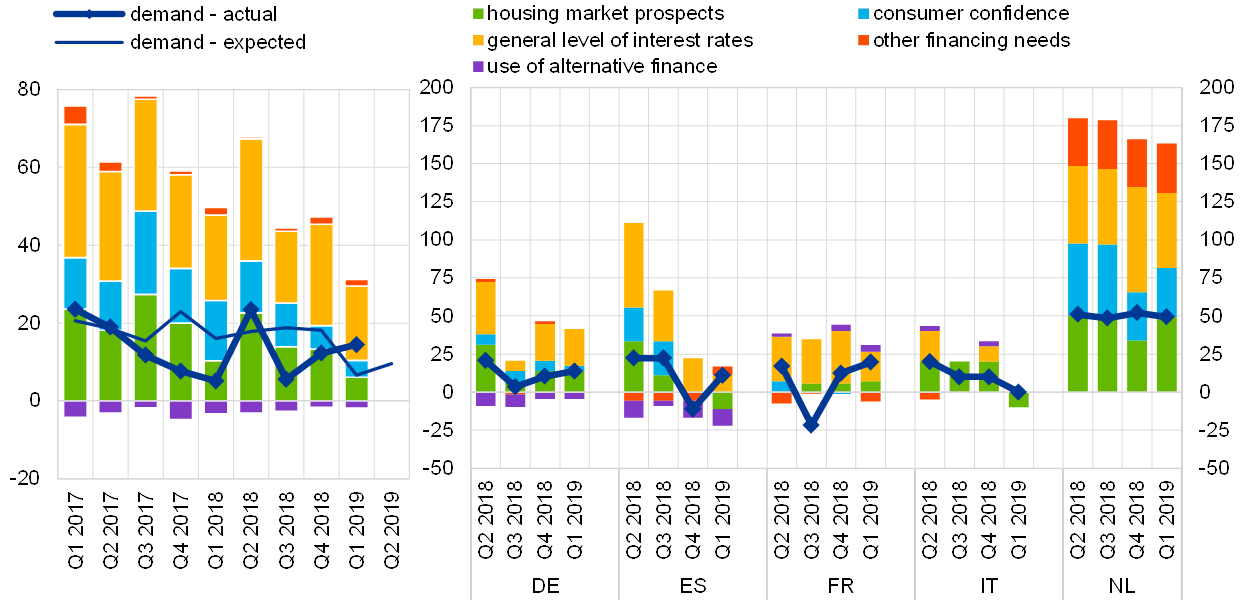
Notes: See the notes to Chart 4. “Other financing needs” is the unweighted average of “debt refinancing/restructuring and renegotiation” and “regulatory and fiscal regime of housing markets”; “use of alternative finance” is the unweighted average of “internal finance of house purchase out of savings/down payment”, “loans from other banks” and “other sources of external finance”.
Table 8
Factors contributing to net demand for loans to households for house purchase
(net percentages of banks)
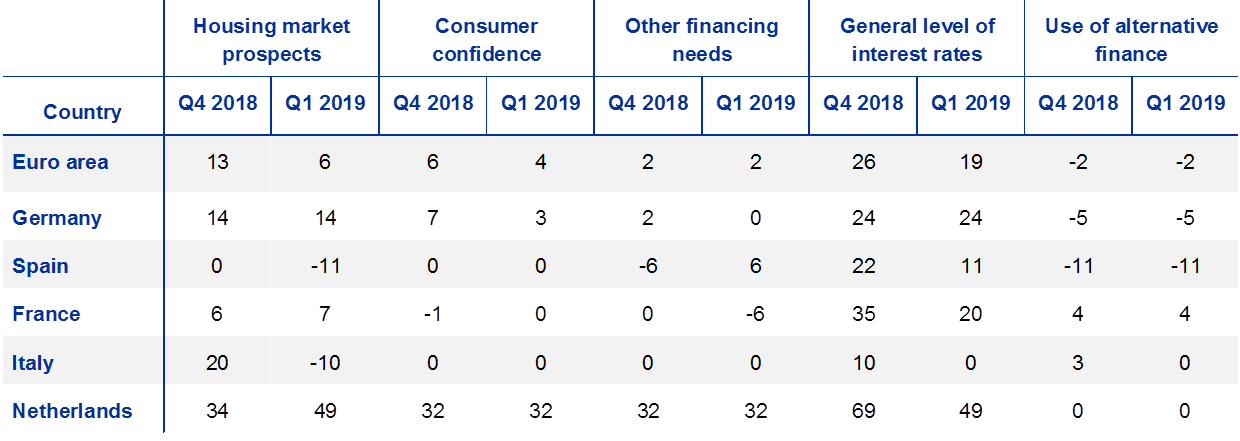
Note: See the notes to Chart 8.
For the second quarter of 2019, euro area banks expect a continued increase in net demand for housing loans (10%).
2.3 Consumer credit and other lending to households
2.3.1 Credit standards for consumer credit and other lending to households tightened slightly
In the first quarter of 2019, credit standards for consumer credit and other lending to households tightened slightly (2%, unchanged from the previous quarter; see Chart 9 and overview table), which was broadly as expected by banks in the previous round. The net percentage was somewhat lower than the historical average since 2003.
Among the largest euro area countries, credit standards on consumer credit and other lending to households remained unchanged in most of the countries, except for Spain, where they tightened.
According to euro area banks, banks’ cost of funds and balance sheet constraints had a small tightening impact, while competition had a small easing impact on credit standards in the first quarter of 2019 (see Chart 9 and Table 9).
Across the largest euro area countries, banks in a majority of the countries reported a neutral impact of most factors. The tightening impact of banks’ cost of funds and balance sheet constraints was related to banks in France. In addition, the easing impact of competition was due to developments in Germany and Italy.
Chart 9
Changes in credit standards applied to the approval of consumer credit and other lending to households, and contributing factors
(net percentages of banks reporting tightening credit standards and contributing factors)
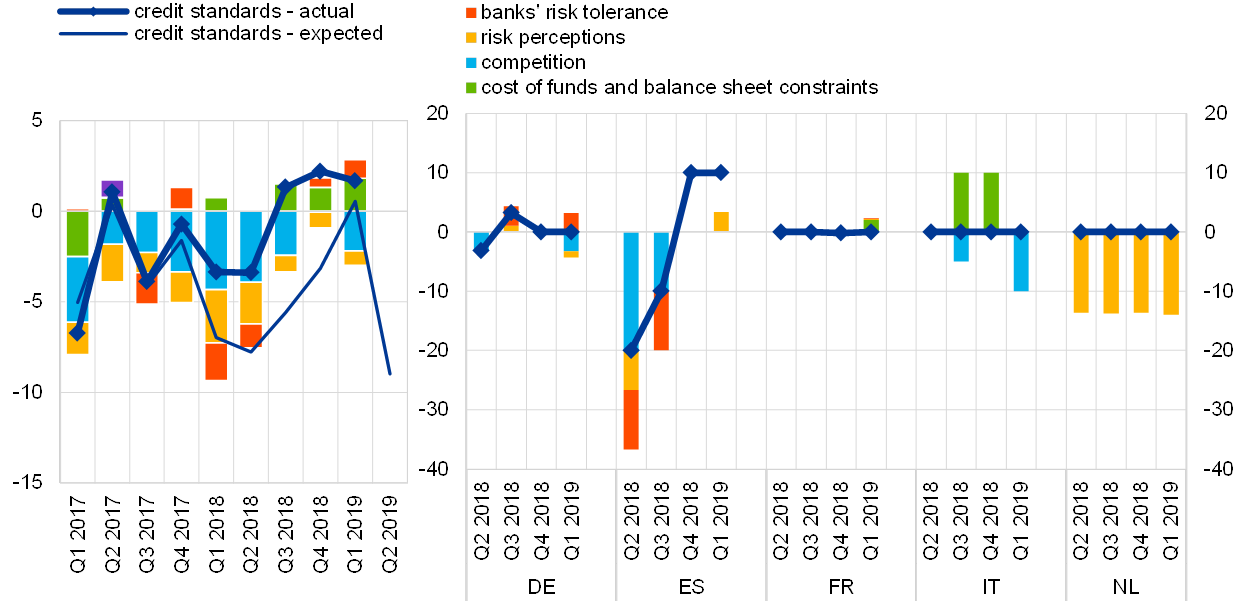
Notes: See the notes to Chart 1. “Risk perceptions” is the unweighted average of “general economic situation and outlook”, “creditworthiness of consumers” and “risk on the collateral demanded”; “competition” is the unweighted average of “competition from other banks” and “competition from non-banks”. “Other factors” are provided by banks when none of the above factors are applicable. They are shown as memo items and refer here, in particular, to changes in regulations and legislation.
Looking ahead to the second quarter of 2019, euro area banks expect an easing of credit standards on consumer credit and other lending to households (-9%).
Table 9
Factors contributing to the net tightening of credit standards for consumer credit and other lending to households
(net percentages of banks)
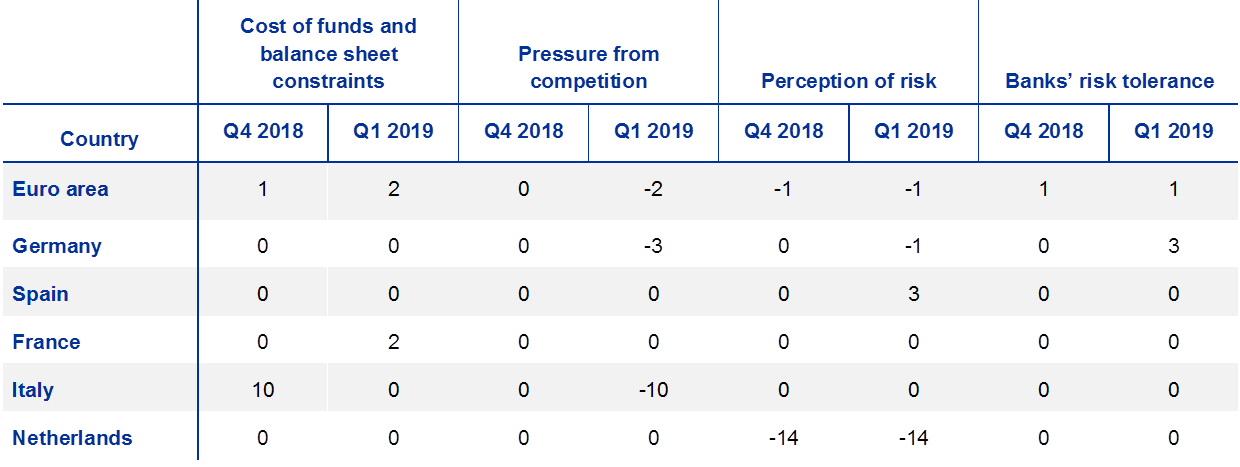
Note: See the notes to Chart 9.
2.3.2 Terms and conditions for consumer credit and other lending to households tightened slightly
In the first quarter of 2019, overall terms and conditions applied by banks when granting new consumer credit and other lending to households tightened slightly. At the same time, margins on average loans continued to narrow, while margins on riskier loans remained unchanged. The other terms and conditions also remained broadly unchanged (see Chart 10 and Table 10).
Across the large euro area countries, overall terms and conditions for consumer credit and other lending to households eased in Germany and Spain, while they tightened in France and the Netherlands and remained unchanged in Italy. The easing in Germany and Spain was reflected in a narrowing of margins on average loans, while margins on riskier loans remained unchanged overall. The tightening of terms and conditions in France was due to a widening of margins on average loans, while for banks in the Netherlands the tightening related to the maturity of consumer credit and other lending to households.
Chart 10
Changes in terms and conditions for consumer credit and other lending to households
(net percentages of banks reporting tightening terms and conditions)
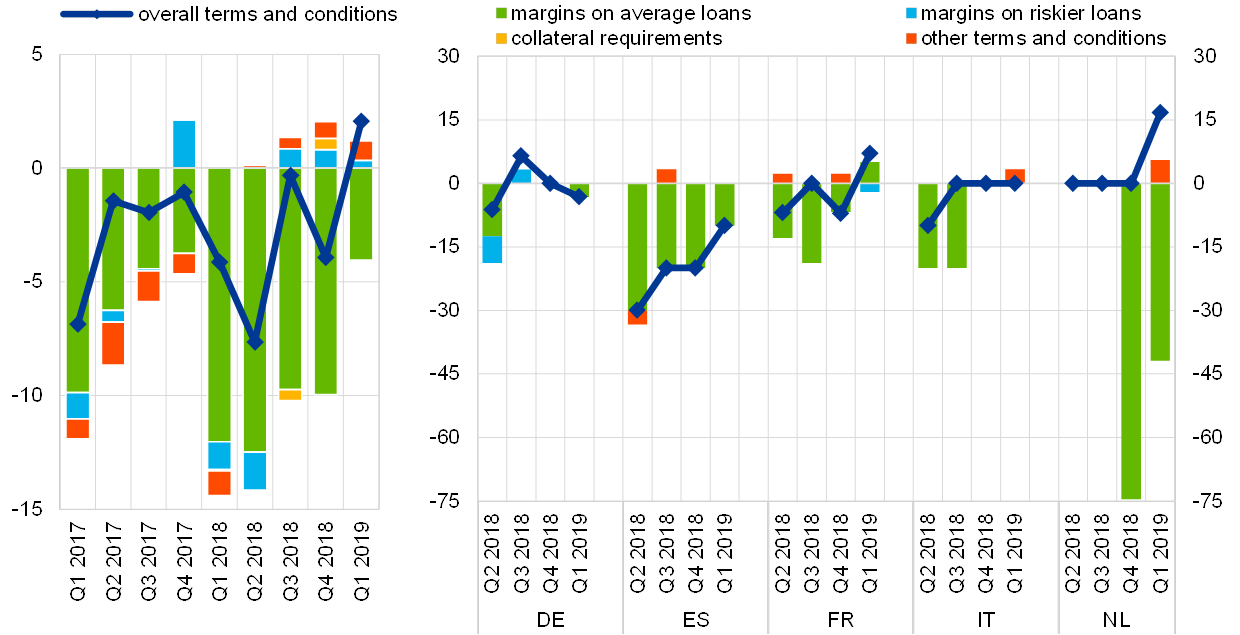
Notes: “Margins” are defined as the spread over a relevant market reference rate. “Other terms and conditions” is the unweighted average of “size of the loan”, “non-interest rate charges” and “maturity”.
Table 10
Changes in terms and conditions for consumer credit and other lending to households
(net percentages of banks)
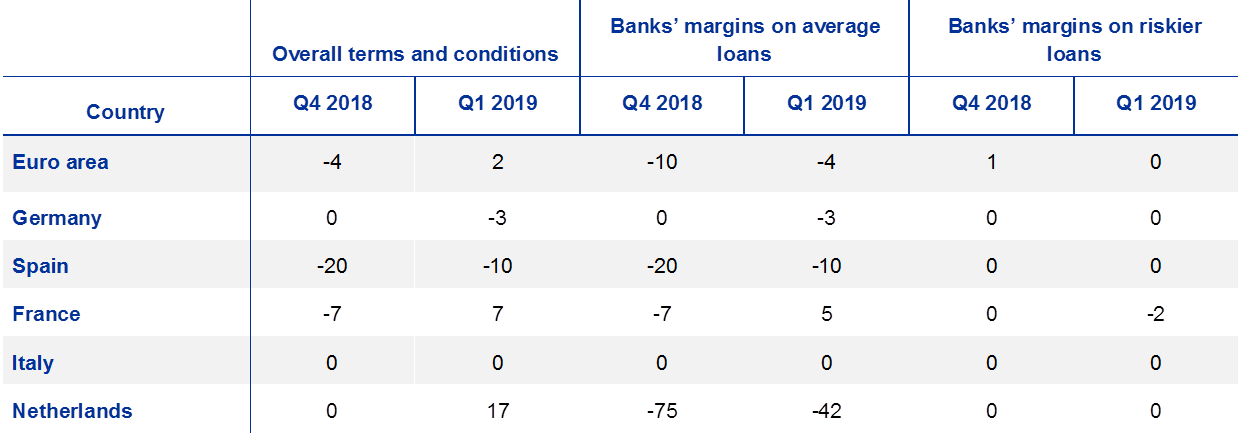
Note: See the notes to Chart 10.
The main factors underlying the tightening of overall terms and conditions were banks’ cost of funds and balance sheet constraints and banks’ risk tolerance, while competitive pressures and risk perceptions continued to contribute to an easing (see Table 11).
Across the largest euro area countries, banks’ cost of funds and balance sheet constraints had a tightening impact on terms and conditions in a majority of the countries, while banks’ risk tolerance had a tightening impact in the Netherlands.
Table 11
Factors contributing to the net tightening of overall terms and conditions for consumer credit and other lending to households
(net percentages of banks)
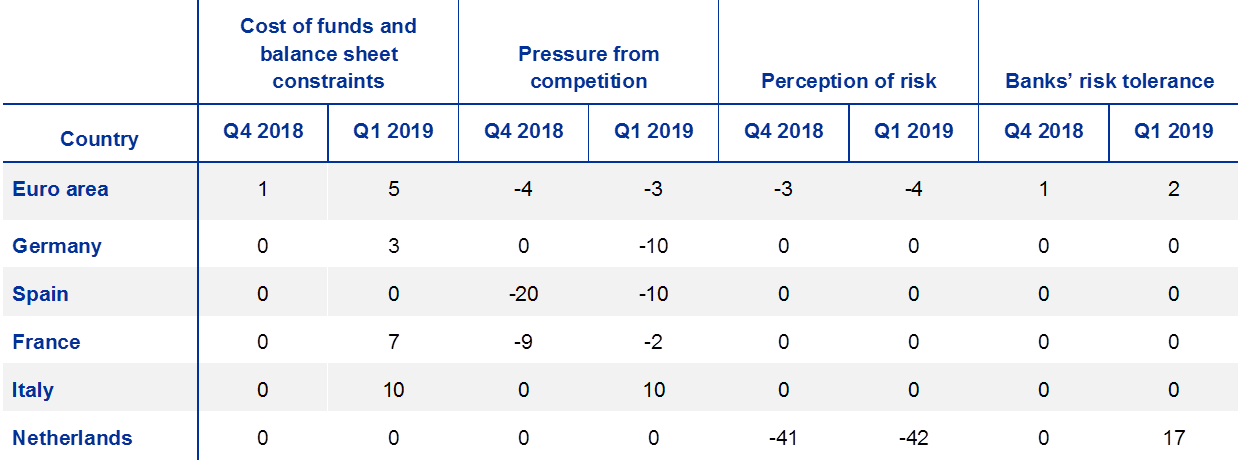
Note: The net percentages for these questions relating to contributing factors are defined as the difference between the percentage of banks reporting that the given factor contributed to a tightening and the percentage reporting that it contributed to an easing.
2.3.3 Rejection rate for consumer credit and other lending to households continued to increase
The net share of rejected applications for consumer credit and other lending to households continued to increase in the first quarter of 2019 according to reporting banks (3%, after 5% in the previous survey round; see Chart 11).
Across the largest euro area countries, the rejection rate increased for banks in Germany and Spain, while it remained broadly unchanged for banks in France, Italy and the Netherlands.
Chart 11
Change in the share of rejected applications for consumer credit and other lending to households
(net percentages of banks reporting an increase in the share of rejections)
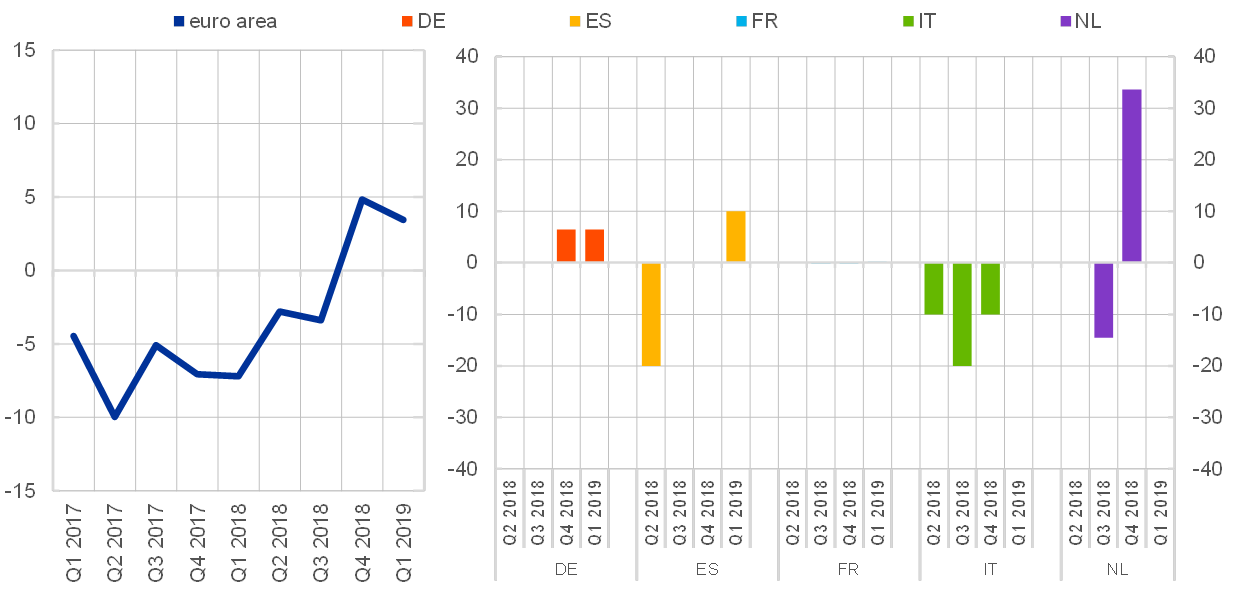
Note: Share of loan rejections relative to the volume of all loan applications in that loan category.
2.3.4 Net demand for consumer credit and other lending to households increased slightly
According to euro area banks, net demand for consumer credit and other lending to households increased slightly in the first quarter of 2019, but the increase moderated considerably (net percentage of 2%, after 8% in the previous quarter; see Chart 12 and overview table). The increase in demand was substantially lower than expected in the previous survey round and stood around its historical average.
Across the large euro area countries, net demand for consumer credit and other lending to households increased in Germany and the Netherlands, while it declined in France and Spain and was unchanged in Italy.
Among the factors driving the demand at the euro area level, the low general level of interest rates and financing needs for spending on durable consumer goods contributed positively to demand, while consumer confidence had a neutral impact (see Chart 12 and Table 12), following a positive impact since the second quarter of 2014. In addition, the use of other financing sources dampened demand at participating banks.
Of the largest euro area countries, the low general level of interest rates contributed positively to demand for consumer credit in all countries. In addition, financing needs for spending on durable goods supported consumer credit in Germany, Italy and the Netherlands, while they dampened demand in France and Spain. Consumer confidence had a mixed impact, dampening demand in France and Italy, but supporting demand in the Netherlands in the first quarter of 2019.
Chart 12
Changes in demand for consumer credit and other lending to households, and contributing factors
(net percentages of banks reporting an increase in demand and contributing factors)
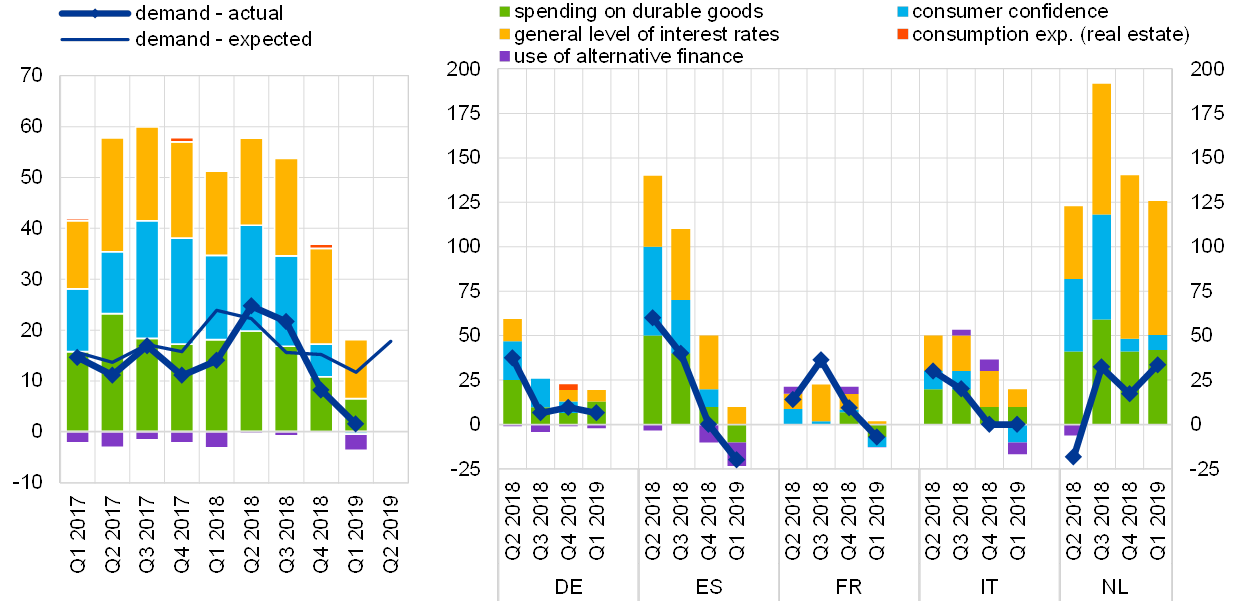
Notes: See the notes to Chart 4. “Use of alternative finance” is the unweighted average of “internal financing out of savings”, “loans from other banks” and “other sources of external finance”. “Consumption exp. (real estate)” denotes “consumption expenditure financed through real estate-guaranteed loans”.
Table 12
Factors contributing to net demand for consumer credit and other lending to households
(net percentages of banks)
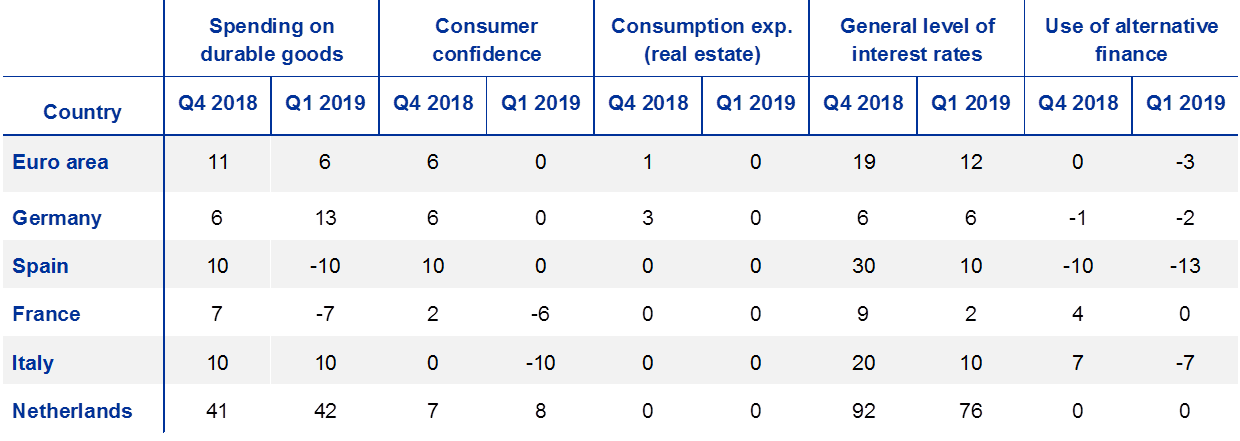
Note: See the notes to Chart 12.
For the second quarter of 2019, euro area banks expect a stronger increase in net demand for consumer credit and other lending to households (18%).
3 Ad hoc questions
3.1 Banks’ access to retail and wholesale funding
As in previous survey rounds, the April 2019 survey questionnaire included a question assessing the extent to which the situation in financial markets was affecting banks’ access to retail and wholesale funding. Banks were asked whether their access to funding had deteriorated or eased over the past three months. Negative net percentages indicate an improvement, while positive figures indicate a deterioration in net terms.
For the first quarter of 2019, in net terms euro area banks reported that their access to wholesale funding had improved for debt securities issuance, in line with bank bond market developments and following a deterioration of market access in the fourth quarter of 2018. To a small extent banks also indicated improved access to money markets, while access to securitisation remained broadly unchanged (see Chart 13 and Table 13).[7] As regards access to retail funding, banks indicated an improvement in the first quarter of 2019.
Chart 13
Banks’ assessment of funding conditions and the ability to transfer credit risk off the balance sheet
(net percentages of banks reporting a deterioration in market access)
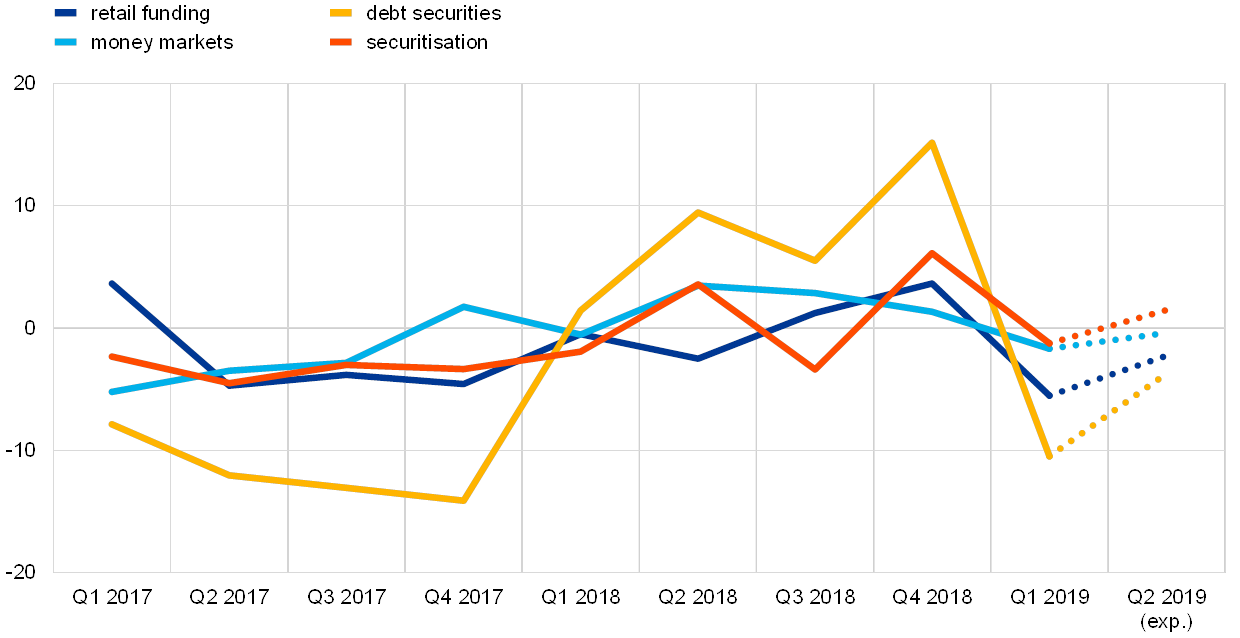
Note: The net percentages are defined as the difference between the sum of the percentages for “deteriorated considerably” and “deteriorated somewhat” and the sum of the percentages for “eased somewhat” and “eased considerably”.
Looking ahead to the second quarter of 2019, euro area banks expect a small further improvement in their access to debt securities markets and retail funding, as well as broadly unchanged access to money markets and securitisation.
Table 13
Banks’ assessment of funding conditions and the ability to transfer credit risk off the balance sheet
(net percentages of banks reporting a deterioration in market access)

Note: See the notes to Chart 13.
3.2 The impact of the ECB’s asset purchase programme
The April 2019 survey questionnaire included two biannual ad hoc questions gauging the impact of the ECB’s asset purchase programme (APP). When answering questions on the impact of the APP over the past and next six months, banks were asked to take account of both the impact of the net asset purchases in the context of the APP until December 2018 and the impact of the reinvestment of the principal payments from maturing securities purchased under the APP. Banks were also asked to consider both direct and indirect effects of the APP, as there may be an indirect impact on their financial situation and asset allocation even if the bank concerned has not been involved in any direct asset sales vis-à-vis the Eurosystem.
In this survey round, banks reported the APP’s impact on their financial situation. In addition, banks also provided an assessment of the APP’s impact on their lending conditions and loan volumes.
3.2.1 Impact of the ECB’s asset purchase programme on banks’ financial situation
Euro area banks reported that over the past six months the APP had contributed to an improvement in their liquidity position and their market financing conditions, but to a deterioration in their profitability (see Chart 14). Over the next six months, euro area banks expect a continued, but somewhat smaller positive impact on their liquidity position and their market financing conditions from the APP.
Chart 14
Overview of the impact of the APP on euro area banks’ financial situation
(net percentages of banks)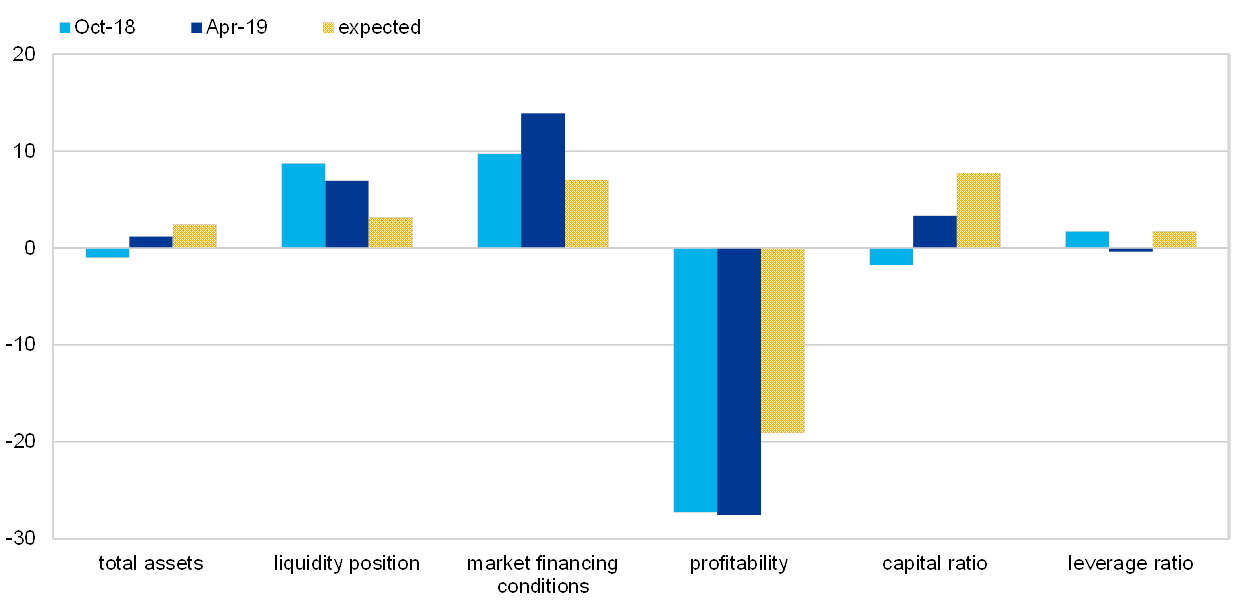
Notes: The net percentages are defined as the difference between the sum of the percentages for “increased/improved considerably” and “increased/improved somewhat” and the sum of the percentages for “decreased/deteriorated somewhat” and “decreased/deteriorated considerably”. The periods in the legend refer to the respective BLS survey rounds. “Expected” denotes expectations indicated by banks in the current round.
In detail, euro area BLS banks reported that the APP had had a broadly neutral impact on their total assets over the past six months (net percentage of banks: 1%, after -1% in the October 2018 survey). At the same time, the APP contributed to a further decrease in their holdings of sovereign bonds (net percentage of -14%, after -18%, see Chart 15). Euro area banks expect a small positive impact on their total assets and a slight decline in their holdings of euro area sovereign bonds over the next six months as a consequence of the APP.
Chart 15
Impact of the APP on euro area banks’ assets and market financing conditions
(net percentages of banks)
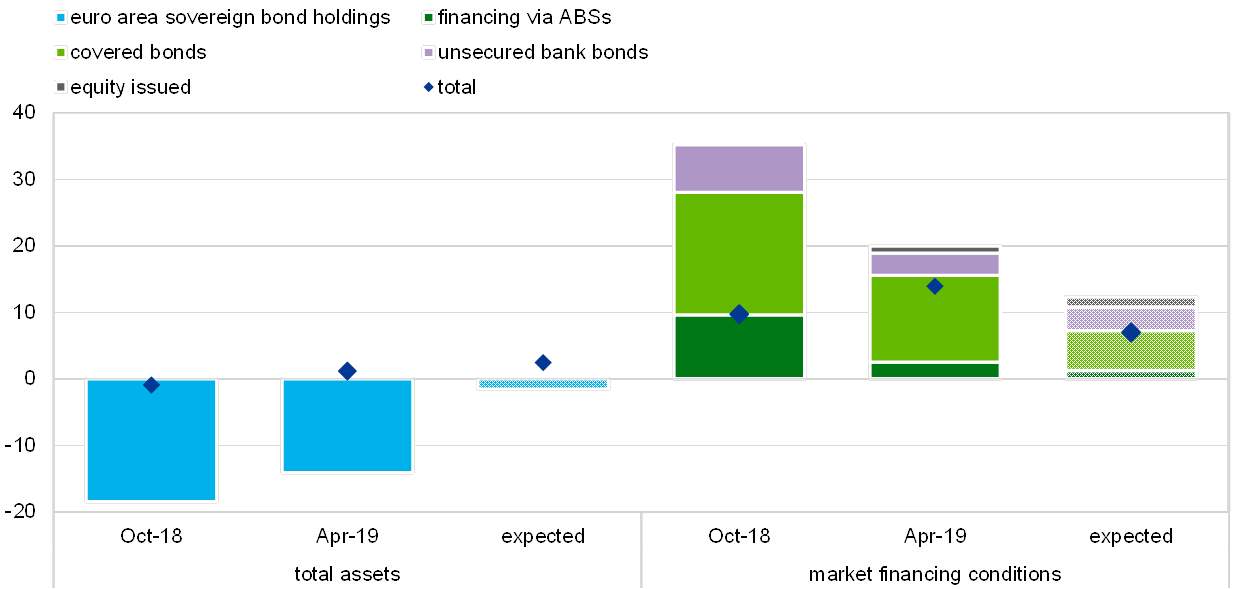
Note: See the notes to Chart 14.
In net terms, banks indicated a positive impact of the APP on their liquidity situation over the past six months (net percentage of banks: 7%, after 9% in the October 2018 survey). Banks expect this impact to diminish over the next six months (net percentage of 3%; see Chart 14).
Euro area banks also reported an improvement in their market financing conditions owing to the APP (net percentage of banks: 14%, after 10% in the October 2018 survey; see Chart 15). This positive impact was mainly related to banks’ financing via covered bonds. Banks expect a somewhat smaller, but continued positive impact of the APP on their market financing conditions over the next six months (net percentage of banks: 7%).
A broadly unchanged net percentage of the euro area BLS banks reported a negative overall impact of the APP on their profitability over the past six months
(-28%, after -27% in the October 2018 survey round; see Chart 16). The negative impact on euro area banks’ profitability was due to a negative impact on banks’ net interest margins (net percentage of banks: -37%, after -31%), whereas the impact from capital gains/losses owing to the APP was broadly neutral (1%, after -2%). Over the next six months, a smaller net percentage of the participating euro area banks expect a dampening impact of the APP on their profitability (-19%).
Chart 16
Impact of the APP on euro area banks’ profitability and capital positions
(net percentages of banks)
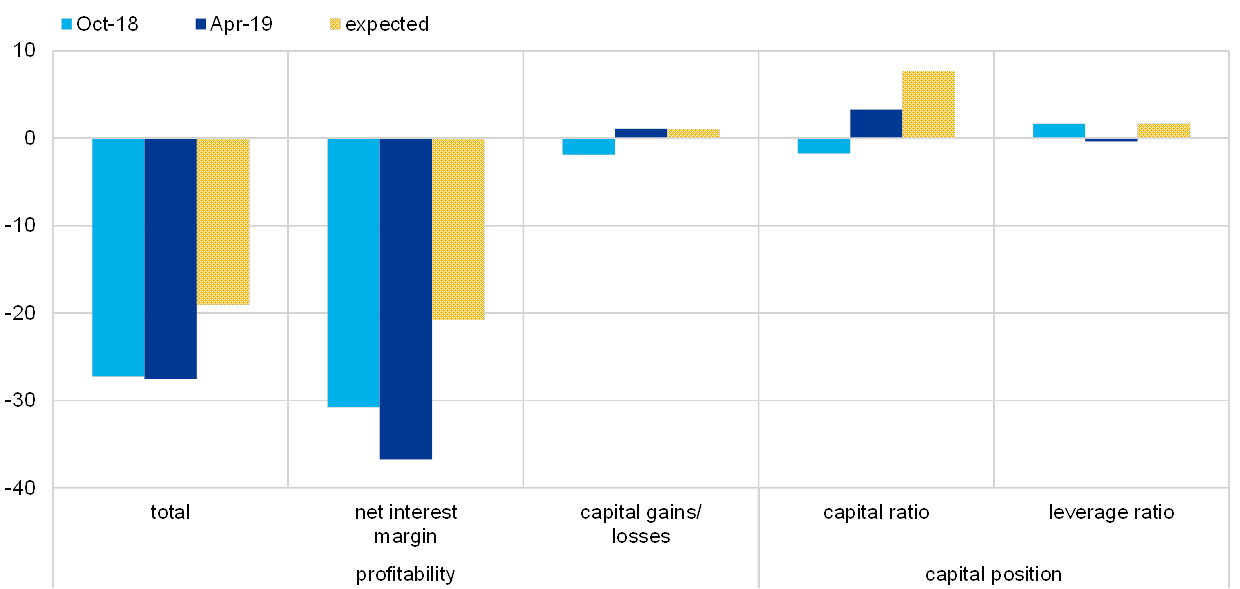
Note: See the notes to Chart 14.
With regard to banks’ capital position, a small net percentage of euro area banks indicated that the APP had contributed to an increase in their capital ratio (3%, after -2%) over the past six months (see Chart 14). In addition, euro area banks indicated a neutral impact of the APP on their leverage ratio (net percentage of banks: 0%, after 2%).
3.2.2 Impact of the ECB’s asset purchase programme on banks’ lending conditions and lending volumes
Euro area banks indicated a broadly neutral impact of the APP on their credit standards across all loan categories over the past six months (for both loans to enterprises and housing loans: -1%, after 0% in the October 2018 survey round; for consumer credit: 0%, unchanged from the October 2018 survey; see Chart 17, left-hand side). Over the next six months, banks expect a broadly neutral impact of the APP on credit standards for loans to enterprises and consumer credit and a small net easing impact on credit standards for housing loans.
Chart 17
Impact of the APP on bank lending conditions
(net percentages of banks)

Notes: The net percentages are defined as the difference between the sum of the percentages for “tightened considerably” and “tightened somewhat” and the sum of the percentages for “eased somewhat” and “eased considerably”. The periods in the legend refer to the respective BLS survey rounds. “Expected” denotes expectations indicated by banks in the current round.
According to reporting banks, the APP continued to have a net easing impact on the terms and conditions of new loans across all loan categories (loans to enterprises:
-3%, after -4% in the October 2018 survey, housing loans: -2%, after -3%, consumer credit and other lending to households: -3%, after -2%; see Chart 17, right-hand side). The favourable impact on terms and conditions is expected by euro area banks to remain broadly similar over the next six months for all loan categories.
Chart 18
Impact of the APP on bank lending volumes
(net percentages of banks)
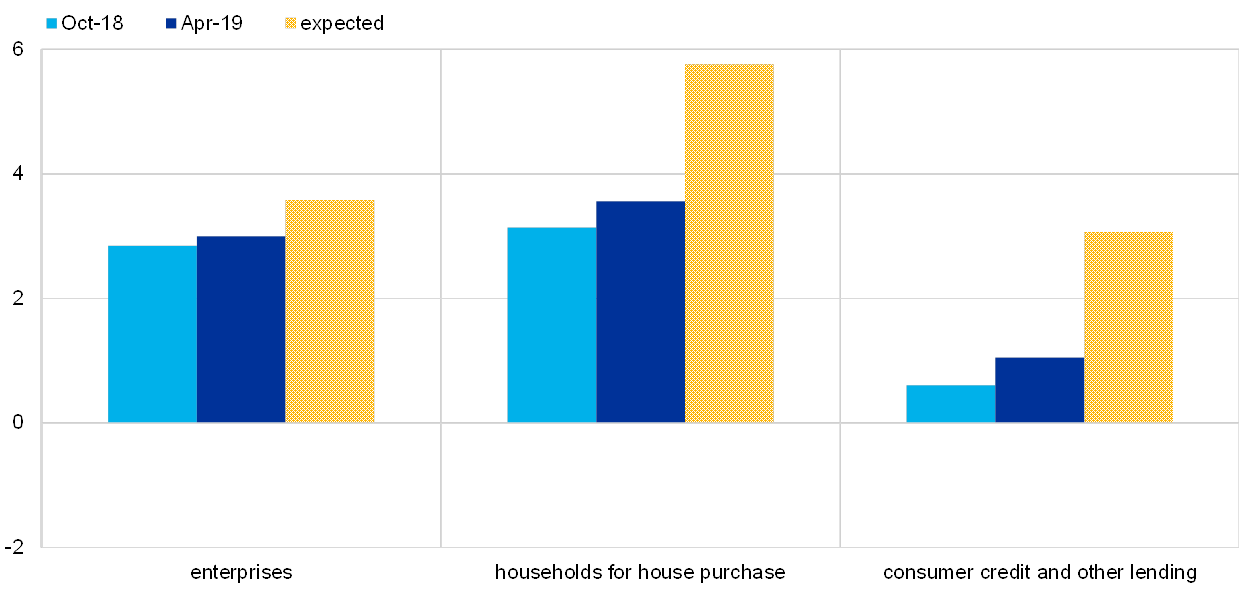
Notes: The net percentages are defined as the difference between the sum of the percentages for “increased considerably” and “increased somewhat” and the sum of the percentages for “decreased somewhat” and “decreased considerably”. The periods in the legend refer to the respective BLS survey rounds. “Expected” denotes expectations indicated by banks in the current round.
Euro area banks were also asked to indicate the APP impact on their lending volumes.[8] They reported a positive impact on their lending volumes for loans to enterprises and housing loans over the past six months (for loans to enterprises: 3%, unchanged from the October 2018 survey; for housing loans: 4%, after 3%; see Chart 18). In addition, banks continued to report a broadly neutral impact of the APP on their lending volumes for consumer credit and other lending to households (1%, unchanged from the October 2018 survey). For the next six months, banks expect a somewhat stronger positive APP impact on their lending volumes across all loan categories.
3.3 The impact of the ECB’s negative deposit facility rate
The April 2019 survey questionnaire also included a biannual ad hoc question aimed at gauging the impact of the ECB’s negative deposit facility rate (DFR) on banks’ net interest income, lending conditions and lending volumes. Banks were asked to consider both direct and indirect effects of the negative DFR, as there may be an indirect impact on banks’ financial situation and lending conditions even if the bank concerned has no excess liquidity.
As regards the effect of the ECB’s negative deposit facility rate on banks’ net interest income,[9] euro area BLS banks continued to report a negative impact on their net interest income over the past six months (net percentage of banks: -73%, after -68% in the October 2018 BLS round; see Chart 19). A similar impact is expected over the coming six months (net percentage of -67%).
Chart 19
Impact of the negative DFR on banks’ net interest income and bank lending
(net percentages of banks)
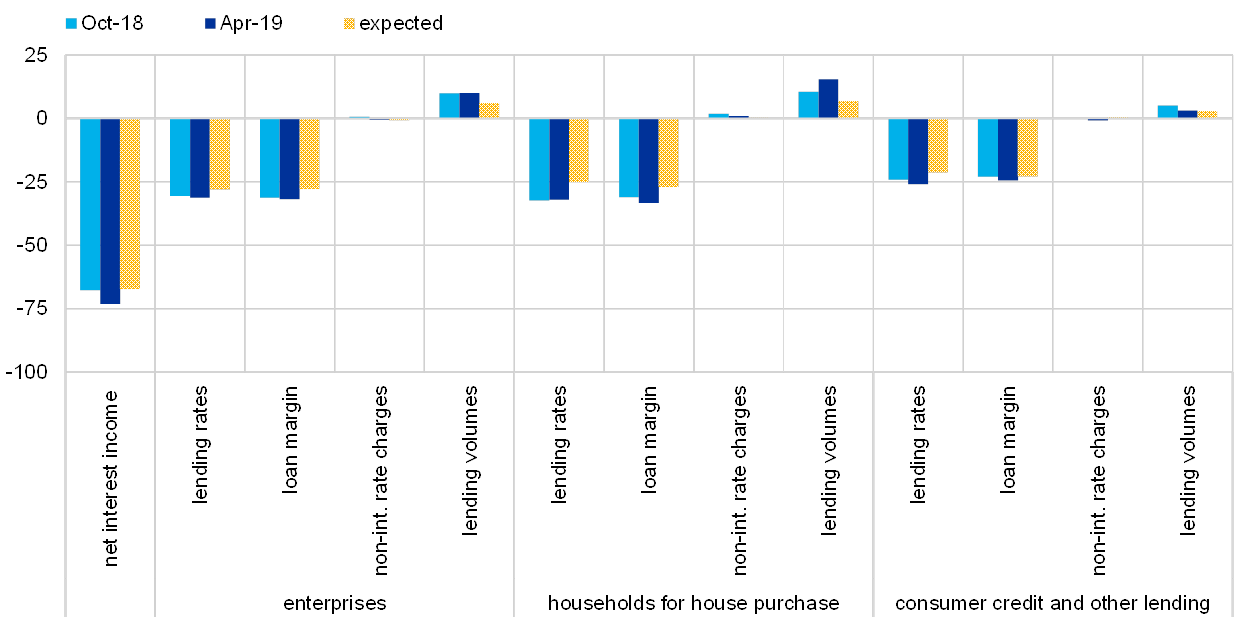
Notes: The net percentages are defined as the difference between the sum of the percentages for “increased considerably” and “increased somewhat” and the sum of the percentages for “decreased somewhat” and “decreased considerably”. The periods in the legend refer to the respective BLS survey rounds. “Expected” denotes expectations indicated by banks in the current round.
Regarding the DFR impact on loans to enterprises, in net terms euro area banks continued to report a decrease in their lending rates over the past six months (net percentage of banks: -31%, unchanged from the October 2018 survey round) and a negative DFR impact on their loan margins[10] (-32%, after 31%; see Chart 19). At the same time, banks indicated a neutral impact of the negative DFR on their non-interest rate charges for loans to enterprises over the past six months (0%, after 1%). In terms of lending volumes to enterprises, banks reported a positive impact of the DFR for the past six months (net percentage of banks: 10%, unchanged from the October 2018 survey round). For the next six months, a smaller net percentage of banks expect a decline of their lending rates (-28%) and loan margins (-28%) owing to the DFR. In addition, in net terms euro area banks expect a broadly neutral impact of the DFR on non-interest charges (-1%) and an ongoing positive effect on lending volumes to enterprises (6%).
Regarding the DFR impact on loans to households for house purchase, overall the impact reported by euro area banks was broadly in line with the impact reported for loans to enterprises. Euro area banks also indicated a negative impact on their lending rates (net percentage of banks: -32%, unchanged from the October 2018 survey) and their loan margins (-33%, after -31%; see Chart 19) over the past six months. At the same time, euro area banks indicated that the negative DFR had had a broadly neutral impact on their non-interest rate charges for housing loans over the past six months (1%, after 2%). In terms of housing lending volumes, euro area banks reported a further positive effect of the negative DFR (16%, after 11%). For the next six months, a smaller net percentage of banks expect a negative impact of the DFR on housing lending rates (-25%) and loan margins (-27%) and a positive impact on lending volumes (7%).
With regard to consumer credit and other lending to households, in net terms 26% of the euro area banks indicated a negative DFR impact on their lending rates over the past six months (after -24%) and 25% indicated a negative impact on their loan margins (after -23%; see Chart 19). At the same time, euro area banks basically did not see any impact of the negative DFR on non-interest rate charges for consumer credit over the past six months (-1%, after 0%). In terms of lending volumes for consumer credit, euro area banks reported a positive effect of the DFR (net percentage of banks: 3%, after 5%). For the next six months, a smaller net percentage of banks expect a negative DFR impact on lending rates (-21%) and loan margins (-23%), while the impact on non-interest charges (0%) and on lending volumes (3%) for consumer credit is expected to remain similar.
3.4 Banks’ current level of credit standards
The April 2019 BLS survey questionnaire included an annual ad hoc question on the current level of credit standards compared with two historical ranges of credit standards, i.e. the levels that prevailed (i) between the first quarter of 2003 and the current quarter, and (ii) between the second quarter of 2010 (i.e. when the sovereign debt crisis started to intensify) and the current quarter. Information on the level of credit standards is useful to put into perspective banks’ replies to the standard questions on the changes in credit standards over the past three months. At the same time, it needs to be acknowledged that an assessment of the current level, in particular compared with a long-term range since 2003, may be difficult for banks and therefore needs to be viewed with some caution.
Chart 20
Level of credit standards for loans to enterprises and households relative to levels since 2003
(percentages of banks)

Notes: “Net percentage” is defined here as the difference between “tighter” (defined for this question as the sum of the percentages of banks reporting “moderately tighter than the midpoint of the range”, “considerably tighter than the midpoint of the range” and “at the tightest level during this period”) and “looser” (defined for this question as the sum of the percentages of banks reporting “moderately looser than the midpoint of the range”, “considerably looser than the midpoint of the range” and “at the loosest level during this period”). The “midpoint of the range” of credit standards is defined as the midpoint between the maximum and the minimum level of credit standards during this time period. “All NFCs” indicates loans to all non-financial corporations, “HP” indicates loans to households for house purchase, and “CC” indicates consumer credit and other lending to households.
In the first quarter of 2019, in net terms a considerably smaller share of the euro area banks (18%, after 34% one year ago) assessed their current level of credit standards for loans to enterprises as tighter than the historical range since 2003 (see Chart 20). The development was driven by 37% (after 45% one year ago) of the banks reporting a tighter level than the historical range and 19% (after 11% one year ago) of the banks reporting looser credit standards compared with the historical range. In addition, a broadly unchanged percentage of banks assessed the level of credit standards as basically identical to the historical range since 2003 (39%, after 40% one year ago). This development reflects the considerable net easing of credit standards on loans to enterprises over the last year, as reported in the standard BLS questions.
When comparing the current level of credit standards on loans to enterprises with the shorter range of credit standards between the second quarter of 2010 and now, in net terms euro area banks assessed their current level of credit standards for loans to enterprises as broadly similar to the range since 2010 (-3%, after -2%; see Chart 21). This development resulted from 24% (after 27% one year ago) of the banks reporting a tighter level compared with the range since 2010 and 27% (after 29% one year ago) of the banks reporting looser credit standards. In addition, the percentage of banks indicating a broadly identical level of credit standards compared with the range since 2010 remained similar (44%, after 41% one year ago).
Chart 21
Level of credit standards for loans to enterprises and households relative to levels since the second quarter of 2010
(percentages of banks)
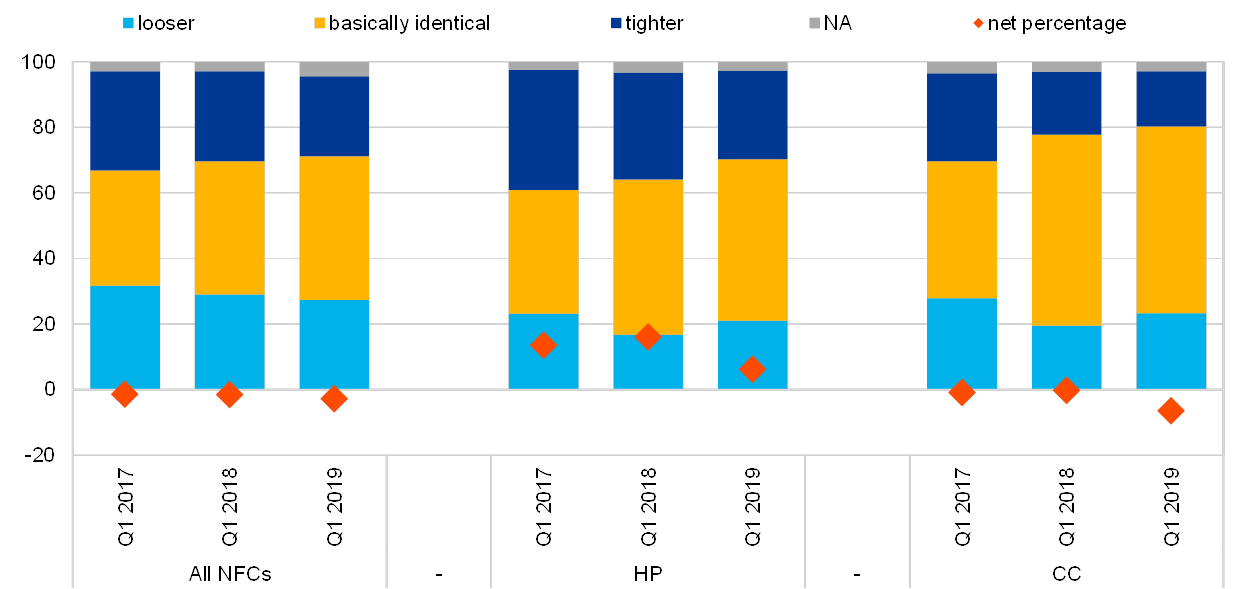
Notes: See the notes to Chart 20.
With respect to loans to households for house purchase, in net terms 25% of the euro area banks (compared with 35% one year ago) assessed their current level of credit standards as tighter than the historical range since 2003 (see Chart 20). This development resulted from 40% (after 48% one year ago) of the banks reporting tighter credit standards compared with the historical range and 15% (after 13% one year ago) of the banks reporting a looser level than the range since 2003. In addition, 41% of the banks (after 35%) assessed the level of credit standards as broadly identical to the historical range.
When comparing the current level of credit standards on housing loans with the shorter range of credit standards since the second quarter of 2010, a net percentage of 6% of the euro area banks assessed their current level of credit standards as tighter (after 16% one year ago; see Chart 21). The development was driven by 27% (after 33% one year ago) of the banks reporting tighter credit standards compared with the range since 2010 and 21% (after 17% one year ago) of the banks reporting a looser level. In addition, 49% of the banks (after 47%) reported that the current level is broadly identical to the range of credit standards since 2010.
With respect to consumer credit and other lending to households, a smaller net percentage of euro area banks (25%, compared with 32% one year ago) assessed their current level of credit standards as tighter than the historical range since 2003 (see Chart 20). This development resulted from 32% (after 38% one year ago) of the banks reporting tighter credit standards compared with the historical range and 7% (after 5% one year ago) of the banks reporting a looser level than the range since 2003. In addition, 57% of the banks (after 53%) assessed the level of credit standards as broadly identical to the historical range.
For the shorter range, i.e. since the second quarter of 2010, in net terms euro area banks reported that the current level of their credit standards on consumer credit and other lending to households is somewhat looser than the range since 2010 (-7%, after 0% one year ago; see Chart 21). This development was driven by 17% (after 19% one year ago) of the banks reporting tighter credit standards and 23% (after 20% one year ago) of the banks reporting a looser level. In addition, 57% of the banks (after 58%) reported that the current level is broadly identical to the range of credit standards since 2010.
Annexes
See more.
© European Central Bank, 2019
Postal address 60640 Frankfurt am Main, Germany
Telephone +49 69 1344 0
Website www.ecb.europa.eu
All rights reserved. Reproduction for educational and non-commercial purposes is permitted provided that the source is acknowledged.
For specific terminology please refer to the ECB glossary.
PDF ISSN 1830-5989, QB-BA-19-002-EN-N
HTML ISSN 1830-5989, QB-BA-19-002-EN-Q
- The five largest euro area countries in terms of gross domestic product are Germany, France, Italy, Spain and the Netherlands.
- For more detailed information on the bank lending survey, see the article entitled “A bank lending survey for the euro area”, Monthly Bulletin, ECB, April 2003; and Köhler-Ulbrich, P., Hempell, H. and Scopel, S., “The euro area bank lending survey”, Occasional Paper Series, No 179, ECB, 2016.
- In this case, the selected sample banks are generally of similar size or their lending behaviour is typical of a larger group of banks.
- The non-harmonised historical data differ from the harmonised data mainly as a result of heterogeneous treatment of “NA” replies and specialised banks across questions and countries. Non-harmonised historical BLS data are published for discontinued BLS questions and ad hoc questions.
- The calculation of a simple average when combining factors in broader categories assumes that all factors have the same importance for the banks. This partly explains some inconsistencies in the respective charts between developments in credit standards and developments in the main underlying factor categories.
- The calculation of a simple average when combining factors in broader categories assumes that all factors have the same importance for the banks. This partly explains some inconsistencies between developments in demand for loans and developments in the main underlying factor categories.
- As regards the results for securitisation, a large number of banks (between 40% and 47%, depending on the type of securitisation) replied “not applicable” on the grounds that this source of funding is not relevant for them.
- Since April 2018, this has replaced the question on the use of the additional liquidity related to the APP for granting loans.
- Net interest income is defined as the difference between the interest earned and paid by the bank on outstanding amounts of interest-bearing assets and liabilities.
- The loan margin is defined as the spread of the bank’s lending rates for new loans over a relevant market reference rate.
-
9 April 2019


